|
|
|
|
|

|
This report catalogs over 100 forms of Kannon in Japan. It features nearly 130 photos, copious reference notes, spellings in multiple Asian languages, and a handy A-to-Z List of Kannon Forms. The Kannon Notebook is an ongoing project aimed at scholars, art historians, practitioners, and laity alike. Presented on one page for easy printout.
Very large page. Give it time to load into your browser.
|
|
English
|
Japanese
|
Chinese
|
Sanskrit / Pali
|
Korean
|
Tibetan
|
|
God or
Goddess
of Mercy &
Compassion
|
Kannon 観音
Kanzeon 観世音
Kanjizai 観自在
Kōzeon 光世音
阿婆盧吉低舍羅
Abarukiteishara
(transliteration)
|
Guānyīn 観音 Guanyin
Guānshìyīn 光世音
Guānzìzài 觀自在
Guānshì Zìzài 觀世自在
阿婆盧吉低舍羅
Āpólújídīshèluó (translitr.)
Kuan Yin, Gwan Yin
|
अवलोकितेश्वर
Avalokitêśvara
Avalokitesvara
Avalokiteshvara
Avalokites'vara
Padma-pâni
|
Gwaneum
Kwanŭm
관음
|
Chen re zi
Chenresig
Spyan ras gzigs
Savior of
the Land
of Snow
|
|
|
|

KANNON MENU
Introduction 
Female or Male?
Shuni-e Repentance Rite
Resources, Learn More
TRADITIONAL FORMS
6 Kannon
11 Headed Kannon
33 Forms of Kannon
1000 Armed Kannon
Batō Kannon (Horse Headed)
Byakue Kannon (White Robed)
Esoteric (Tantric) Forms of Kannon
Feminized Forms of Kannon
Fudarakusen (Kannon’s Paradise)
Fukūkenjaku (Never Empty Lasso)
Guze Kannon (Prince Shōtoku)
Gyoran Kannon (Fish Basket)
Hatakiri Kannon (Cloth Ripping)
Henge Kannon (Esoteric Forms)
Hitokoto Kannon (One Prayer)
Jibo Kannon (Loving Mother)
Juntei Kannon (Mother of All Deities)
Jūichimen Kannon (Eleven-Headed)
Kanzeon or Kanjizai (aka Kannon)
Kebutsu (small image attached)
Koyasu Kannon (Child Giving)
Kudara Kannon (Korea), 7th C.
Kumen Kannon (Nine Headed)
Kuse Kannon, Kuze Kannon
Maria Kannon (Christian)
Miracle Stories About Kannon
Nyoirin Kannon (Omnipotent One)
Roku Kannon (Six Kannon)
Ryūzu Kannon (Dragon-Riding)
Sanjūsanshin (33 Forms of Kannon)
Senchū Yūgen Kannon (Calms Raging Sea)
Senju Kannon (1000 Armed)
Shō Kannon (Sacred, Non-Esoteric)
Six Kannon (Esoteric)
Suigetsu Kannon (Water-Moon)
Tara Bosatsu (Female Manifestation)
Yakuō Kannon (Medicine King)
Yōkihi Kannon (Feminine Ideal)
Yōryū Kannon (Willow Kannon)
Yume-Chigai Kannon (Dream Changer)
Yumedono Kannon (Guze Kannon)
MODERN FORMS
Big Kannon Statues (Attract Tourism)
Bokefuji Kannon (Stop Dementia)
Dōbutsu Kannon (Pet Cemetaries)
Fure-ai Kannon (“Touch Me” Kannon)
Karamatsu Kannon (Safe Delivery)
Mizuko Kannon (Abortion)
War Dead Kannon (Patroness)
RELATED PAGES
28 Legions Serving Kannon
Amida Triad (Kannon)
Kannon Photo Tour
Kannon Photo Tour (Asuka)
Kannon Pilgrimage Kamakura
Kannon Pilgrimages Nationwide
Kannon Statues eStore
Maria Kannon (Christianity)
Objects / Symbols / Weapons
Patrons of Motherhood
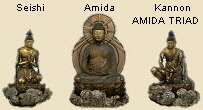
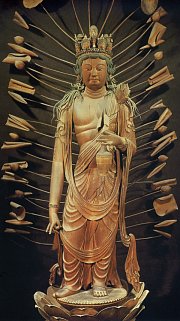
11-Headed Kannon, Wood
Hokkeji Temple 法華寺, Nara,
H = 100 cm, First Half 9th Century
Holds water jar containing Jōsui 浄水,
a miraculous elixir that relieves the
thirst of devotees; aurole depicts
lotus buds and lotus leaves.
Photo courtesy Serai, Oct. 20, 2005

Nine-Headed Kannon
Kumen Kannon 九面観音, 8th century.
Hōryūji Temple 法隆寺, Nara.
National Treasure
Photo: 日本の国宝, #002, March 1997
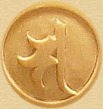
Kannon’s Sanskrit Seed
Pronounced SA in Japanese

おん あるりきゃ そわか
On Arurikya Sowaka
(also Om Arurikya Sowaka)
Kannon’s Shingon Mantra

Oṃ Maṇi Padme Huṃ
Lit. “the jewel in the lotus”
Tibetan Mantra for Avalokitêśvara
ENGLISH TRANSLATIONS
- Bodhisattva of Compassion
- Goddess of Mercy
- God of Compassion
- One Who Hears the
Prayers of the World
- One Who Observes the
Sounds of the World
- One Who is Sensitive to the Sufferings of the World
- Hearer of the World's
Sounds (or World's Cries)
- Lord Who Looks Down with
Pity on All Living Beings
- One Who Attends to the
Cries of the DistressedProtector of the Afflicted
- Lord Who Regards All
|
|
|
|
|
|
KANNON BODHISATTVA, KANNON BOSATSU
LORD OF COMPASSION, GODDESS OF MERCY
Comes in Many Forms, Many Manifestations.
Represented in Artwork as Male or Female.
Assists People in Distress in Earthly Realm
and in all Six Realms of Karmic Rebirth.
One of Asia’s and Japan’s most beloved deities. Kannon worship remains non-denominational and widespread.
- ORIGIN = India. Kannon personifies compassion and is one of the most widely worshipped divinities in Asia and Japan in both ancient and modern times. Kannon’s origins are unclear, but most scholars agree that Kannon worship began in India around the 1st or 2nd century AD and then spread to Southeast Asia, China, Korea, and most other Asian nations. Veneration of Kannon in Japan began in the late 6th century, soon after Buddhism reached Japan by way of Korea and China. In Japan, Kannon’s paradise is known as Fudarakusen. It is commonly said to be located at the southern tip of India (which supports theories of Kannon’s Indian origin). Many Kannon statues from Japan’s Asuka Era (538 to 710) are still extant. Originally male in form, Kannon is now often portrayed as female in China, Japan, and other East Asian countries. Each of these nations dressed Kannon in different forms to suit their own temperaments and spiritual concepts.
- TRANSLATION. Avalokitêśvara is a Sanskrit term, masculine in gender, that translates as Lord Who Regards All (avalokita = observe, iśvara = unimpeded). Īśvara, another name for Śiva, Mahêśvara, or Īśvaradeva (the king of the deva), is a likely component of the name Avalokitêśvara. The Sino-Japanese term Kannon 観音 (Chinese = Guānyīn) literally means watchful listening, and is often translated as “one who sees / hears all.” This is indeed the task of the compassionate Kannon — to witness and listen to the prayers and cries of those in difficulty in the earthly realm, and to help them achieve salvation. Another Japanese name for Kannon is Kanzeon 観世音, the one who constantly surveys (kan 観) the world (ze 世) listening for the sounds (on 音) of suffering. It was later shortened to Kannon.
- SCRIPTURAL BASIS. Kannon is a Bodhisattva (Jp. = Bosatsu), one who achieves enlightenment but postpones Buddhahood until all can be saved. Kannon is mentioned in numerous Mahayana sutra (religious texts), especially the Lotus Sutra 法華経 (Hokekyō), which was translated into Chinese by Kumārajīva (Jp. = Kumarajū 鳩摩羅什, 350 - 410), who rendered Kannon’s name as “One Who Observes the Sounds of the World.” Kannon also appears in the Kegonkyō 華厳経 (Skt. = Avatamsaka Sutra) and Hannya Shingyō 般若心経 (Skt. = Prajnaparamita Sutra; Engish = Heart Sutra), as well as in scriptures of the pure land school like the Muryōju-kyō 無量寿経, and in tantric (esoteric) texts such as Jūichimen Kanzeon Shinju-kyō and Senju Sengen Darani-kyō.
- MEMBER OF PURE LAND SECTS. Kannon is an active emanation of Amida Buddha, and thus s/he occupies a major place in the liturgy of Japan’s Pure Land (Jōdo 浄土) sects, whose principal deity of worship is Amida. In Mahayana Buddhism throughout Asia, Kannon is the most important of Amida’s two main attendants (kyōji 脇侍). The other is Seishi Bosatsu. In Japan, the three appear in a popular grouping known as the Amida Sanzon (lit. = Amida Triad), with Amida in the center, Seishi (representing wisdom) on the right, and Kannon (representing compassion) on the left. See photo in adjacent sidebar. In another popular grouping known as the Amida Raigō (Amida’s Welcoming Descent), the three are typically shown atop clouds descending from above to welcome the souls of the dying -- those on their death bed who are faithfully chanting Amida’s nenbutsu 念仏 (a set phrase for praying to Amida which is “Namu Amida Butsu” 南無阿弥陀仏, meaning All Hail Amida Buddha). Kannon is also one of 25 Bodhisattva who descend from heaven with Amida to welcome dying souls into Amida’s Pure Land. In triad and other artwork, the top of Kannon's crown is often adorned with a small image of Amida (called a Kebutsu 化仏), symbolizing Kannon’s role as Amida’s principal attendant. Jizō Bosatsu, like Kannon, is one of Amida Buddha’s main attendants and, like Kannon, is one of the most popular modern deities in Japan’s Pure Land (Jōdo 浄土) sects. The two share many overlapping functions -- both protect the Six Realms of Karmic Rebirth (the Six Jizō, the Six Kannon), both are patrons of motherhood & children (the Koyasu Jizō, the Koyasu Kannon), and both protect the souls of aborted children (the Mizuko Jizō, the Mizuko Kannon). In some scriptures, they even share the same Ennichi 縁日 (Holy Day). The 18th day of each month is considered Kannon’s Ennichi. Jizō’s Ennichi is generally on the 24th, but at many temples it occurs on the 18th.
- FEMININE VERSIONS. Although depicted with masculine features in the earliest representations, Kannon later appears with attributes of both genders and eventually becomes a symbol of the divine feminine, the divine mother in both China and Japan. Popular feminine versions in modern Japan include Koyasu Kannon (child giving), Jibo Kannon (loving mother), Gyoran Kannon (carrying fish basket), and others. Kannon’s Śakti is Tara Bosatsu, who is sometimes depicted as Kannon’s wife; Śakti is Sankrit for “female personification or avatar of the male.” Feminized forms of Kannon also exist in Japan’s Christian and Shintō traditions, notably Maria Kannon (Virgin Mary) and the Shintō Sun Goddess Amaterasu (often paired with Kannon in Japan’s Kami-Buddha matrix).
- KANNON PILGRIMAGES. Kannon can appear in many different forms to save people. The Lotus Sutra (Hokekyō 法華経), one of the most popular Mahayana scriptures throughout Asia owing to its message that anyone, whether male or female, has the potential to attain Buddhahood, mentions 33 (thirty-three) forms that Kannon assumes when aiding sentient beings. In modern Japan, Kannon’s 33 forms are the basis for hundreds of Kannon Pilgrimage Circuits. Among the best known are the Saigoku Pilgrimage to 33 sites (Kansai area), the Bandō Pilgrimage to 33 sites (Kantō area), and the Chichibu Pilgrimage to 34 sites (Saitama Valley). These three circuits cover 100 sites, and making the pilgrimage to each site in proper order is said to save the believer from hell and to open the gates to everlasting life. The Lotus Sutra is the scriptural basis for these pilgrimage circuits.
- ESOTERIC KANNON FORMS. In addition to the 33 Forms of Kannon, this deity also comes in six salvific forms to save all sentient beings trapped in the Six Realms of Karmic Rebirth (the cycle of suffering, the cycle of samsara). Kannon is also one of the 13 Buddha 十三仏 (Jūsanbutsu) of Japan’s Shingon sect of Esoteric Buddhism (Mikkyō 密教) invoked in memorial services for the dead. In this role, Kannon presides over the memorial service held on the 100th day following one's death.
- ENNICHI (Holy Day). The 18th day of each month is considered Kannon’s Ennichi 縁日, literally "related day" or “day of connection.” This is translated as holy day, one with special significance to a particular Buddha or Bodhisattva. Saying prayers to the deity on this day is believed to bring greater merits and results than on regular days. Says the Digitial Dictionary of Buddhism (login = guest): “The deity is understood to be in special charge of mundane affairs on that day, e.g. the 5th is Miroku, 15th Amida, 25th Monju, 30th Shaka. According to popular belief, religious services held on such a day will have particular merit.” <end quote> See Ennichi list for 30 Deities (Sanjūn Nichi Hibutsu 三十日秘仏; Japanese only).
- MANDALA. In Japan’s Taizōkai Mandala, Kannon appears in esoteric forms in the Lotus Court (Rengebu-in 蓮華部院), which is also known as the Kannon Court (Kannon-in 観音院). These and other esoteric Kannon forms are classified into the Kannon-bu 観音部 (lit. = Kannon family).
- Worshipped independently as a savior par excellence by many sects, including Japan’s Pure Land Sects (devoted to Amida), the Nichiren sect, the Zen sect, the Tendai and Shingon sects of Esoteric Buddhism, indeed, by nearly all Buddhist sects. Kannon worship is essentially non-denominational and widespread.
- In Japan, numerous historical figures are considered emanations of Kannon, including Prince Shōtoku Taishi (Japan’s first great patron of Buddhism), Daruma (the founder of Zen Buddhism), and Chūjō Hime 中将姫 (a Buddhist nun regarded as one of Japan’s greatest early embroidery artists). To Tibetans, the current Dalai Lama is an incarnation of Kannon. The powerful protector deity Bishamonten (the lord of the north, one of the Four Heavenly Kings, and one of Japan’s Seven Lucky Gods) is also considered a manifestation of Kannon. See Bishamon & Kannon at Kurama Dera (Kyoto).
- Senju Kannon (aka the 1000-Armed Kannon) is the Guardian of People Born in the Zodiac Year of the Rat.
- Buddhism for the Common Folk. The three deities Amida, Kannon, and Jizō, became especially popular among the common folk during the Kamakura Period (1185 - 1333 AD), and today remain the bedrock of Buddhism for the common folk. Amida for the coming life in paradise, Kannon for salvation in earthly life, and Jizō for salvation from hell. See From Court to Commoner Buddhism.
- New forms of Kannon have emerged in modern Japan to deal with contemporary issues such as Alzheimers (dementia), with abortion, and with caring for deceased pets. Additionally, in recent decades, many giant effigies of Kannon have been erected to pray for world peace and to honor war veterans (those who died in war).

FORMS OF KANNON IN JAPAN (arranged alphabetically)
Kannon is one of Asia’s and Japan’s most beloved deities. Kannon worship remains non-denominational and widespread. S/he appears in countless forms throughout Japan to assist with all manner of earthly petitions and to protect all those trapped in the six realms of karmic rebirth, especially the human realm. Some of Japan’s innumerable Kannon emanations (both traditional and modern) include: .
 Batō Kannon 馬頭観音 Batō Kannon 馬頭観音
Horse-Headed Kannon. Protector of Animals. Batō Kannon appears in the Mahāvairocana Sūtra (Jp. = Dainichikyō 大日經; composed sometime in the 6th / 7th century AD) and other tantric texts. He is thus a member of the esoteric pantheon. Batō is also one of the Six Kannon. In this latter role, Batō protects those reborn in the animal realm (chikushōdō 畜生道), a realm characterized by stupidity and servitude. Effigies of the Six Kannon began appearing in Japan in the early-mid 10th century onward and were prayed to for the welfare of the dead. The scriptural basis for the six can be traced back to a late 6th-century Tendai text from China, although Batō was not part of the original six but rather inserted some four centuries later. See Six Kannon for details.
Batō Kannon is also one of the Myō-ō 明王 (Skt. = Vidyārāja), the warlike and wrathful deities of Esoteric Buddhism. In this role, the deity is known as Batō Myō-ō 馬頭明王 and included in a grouping known as the Hachidai Myō-ō 八大明王 (lit. Eight Great Myō-ō; Chn. = Bā Dà Míngwáng).
In Japan, farmers pray to Batō Kannon for the safety and preservation of their horses and cattle. Batō Kannon is not only said to protect dumb animals, particularly those who labor for mankind, but extends those powers to protecting their spirits and bringing them ease and a happier life than they experienced while on earth. (Source: Myths and Legends of Japan, by F. Hadland Davis, 1913)
In esoteric traditions, Batō Kannon appears in the Taizōkai (Womb World) Mandala in the Lotus Court (Rengebu-in 蓮華部院), also known as the Kannon-in 観音院.
Says the Digital Dictionary of Buddhism (abridged; sign in with user name = guest): “In Japan, from the beginning of the Tokugawa period, steles of Batō Kannon were dedicated to a deceased horse, as attested by numerous roadside steles bearing its figure and the inscription 馬供養 uma kuyō. In the Japanese Shingon tradition, Batō Kannon is the strong protector of the bodhimaṇḍa (Skt. = awakening seat; the place where one attains enlightenment). Batō Kannon is invoked during the Jūhachidō 十八道 practice when closing the vajra net to seal the sacred space. <end DDB quote> Jūhachidō means eighteen paths. In the two mandala of the esoteric sects, each has nine principal objects of worship. Practitioners devote themselves to meditating on one of these eighteen each day. <Source: DDB>
Says JAANUS (abridged): Batō Kannon. Kannon in an angry (funnu 忿怒) form. Batō is also considered to be the angry form of the Buddha Muryōju (Muryoju) 無量寿. He is distinguished by the white horse's head that he wears like a crown. The horse is one of the symbols of dominion of the "Ideal King" (Kyōryōrinjin 教令輪身 or Kyōryōjō-ō 教令聖王), known as Chakravartin in Sanskrit. There are many different forms of Batō having one to three faces and two to eight arms, and he holds different attributes in different images. In the Kannon Section of the Taizōkai Mandala 胎蔵界曼荼羅, he has three faces and two arms, is red in color, and makes the komponin 根本印 hand gesture (mudra) in front of his chest. However, in art forms, he appears most commonly with three faces and eight arms. The cult of Batō appears not to have been as popular as those of the other esoteric Kannon, although it is recorded that an image of Batō was enshrined in Saidaiji Temple 西大寺 in Nara in the late 8th century. Batō is sometimes found in sets of the Six Kannon, but independent images dating from the Heian period (794-1185) are rare.
Well-known examples dating from the Kamakura and Muromachi periods include the standing statues in Kanzeonji Temple 観世音寺 in Fukuoka prefecture and Jōruriji (Joruriji) Temple 浄瑠璃寺 in Kyoto, as well as the painted image of seated Batō in the Boston Museum of Art. In the Edo period (1600-1868), Batō came to be worshipped as a protector of horses due to his iconography and his role as savior of those in the realm of animals. Many remaining stone statues (sekibutsu 石仏) of Batō were once set in place to protect travelers and their horses from injury on dangerous paths. It is also thought that Batō became conflated with a folk horse deity believed to be the vehicle of a Shintō deity (kami 神) who rides between this world and the sacred realm. Because of this identification, he became the protector of horses and the Buddhist counterpart (honjibutsu 本地仏) of deities of common Komagata 駒形 (lit. "Horse-shaped") shrines, which are found all over Japan. <end JAANUS quote>.
Says site contributor GABI. “By neighing like a horse, the deity wards off bad demons. She is especially honored by the horse breeders in northern Japan. Nowadays you even find bicycles in front of the many stone votive statues to Batō on waysides. There is also a version with the head of an ox (Gotō Kannon 牛頭観音) or a pig (Tontō Kannon 豚頭観音). There is also a special mudra for the horse-headed deity called the Batō Myō-in, Bakō-in (or makō-in) -- as quoted from Ashida and Hanayama.” <end GABI quote>

|
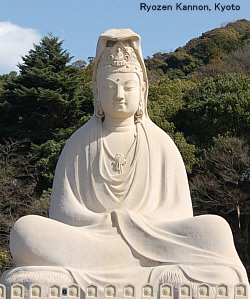
Learn More About Big Kannon Statues
|
|
 Big Kannon Statues Big Kannon Statues
Gigantic effigies of Kannon are known as Dai-Kannon 大観音. Japan has always had a penchant for constructing massive statues (Daibutsu 大仏, lit. = Big Buddha). Dozens of Big Buddha statues have been erected in recent times (post WWII onward). Many of these recent additions were made largely for the goal of increasing tourism to certain Japanese localities, while others were erected to pray for world peace and the repose of the war dead.
PHOTO: Ryōzen Kannon 霊山観音, Kyoto.
Made with 500 tons of concrete with steel-rod frames, this giant effigy of the White-Robed Kannon was unveiled in 1955 to commemorate the soldiers who died in World War II and to pray for a peaceful Japan. The memorial’s own brochure is entitled “A Tribute to The Unknown Soldier, World War II.” Made by famous Showa-era sculptor Yamazaki Chōun 山崎朝雲 (1867 - 1954).
NOTE: Ryōzen refers to Ryōju Sen 靈鷲山 (Skt. = Gṛdhrakūṭa-parvata). Translated into English as Vulture Peak or Eagle Mountain. A mountain site in modern-day Rājgīr (Bihār state, India) where the Buddha gave several sermons, including the beloved Lotus Sūtra so dear to Kannon devotees.

|
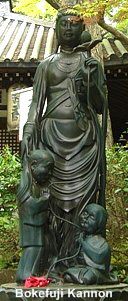
Imakumano-Kannon-ji Temple
今熊野観音寺 (Kyoto)
Elderly couple praying at its feet
|
|
 Bokefuji Kannon 呆け封じ観音 Bokefuji Kannon 呆け封じ観音
Kannon who prevents dementia in the elderly. A modern form of Kannon. Writes scholar Mark R. Mullins: “Another new role for Kannon is connected to the ’graying’ of Japanese society and the increasing concerns of the elderly about growing old, fears of senile dementia (and Alzheimer's disease), and long illnesses followed by an unpleasant death. Kannon's powers have been expanded to include the ’suppression of senility’ (boke-fuji 呆け封じ), and s/he has become a central figure in Pokkuri-Dera ポックリ寺, or temples where the elderly -- those lacking adequate family support -- go to pray for a sudden or painless death. What distinguishes this Kannon from others are a pair of elderly male and female figures kneeling at its feet in a gesture of supplication. An entirely new medical role is thus being attributed to Kannon, who is here called the Kannon Who Heals or Prevents Senility (Bokefuji Kannon). It was not a monk-artisan who made this Kannon at the impulse of piety. Rather, it was produced by professional designers employed by a company in Japan's flourishing religious-goods industry.” <end Mullins quote>
A small temple in Kurayoshi (Ōhirayama, Konpira-In 大平山 金毘羅院) is famous for a Kannon statue that prevents dementia in the elderly. See Gabi Greve for details.

 Byakue Kannon 白衣観音 Byakue Kannon 白衣観音
White-Robed Kannon. Also called Byakushozon 白処尊 or Byakue Kanjizaimo 白衣観自在母. One of 33 Kannon Forms. Prevents sickness and disaster, grants fertility and safe childbirth, and assists in raising children. Appears in various sutras. Part of the esoteric pantheon.
Photo at Right: White-Robed Kannon in Ōfuna, Japan. Height = 29.39 meters. Work on this statue began in 1934, but the outbreak of WWII halted its construction, which began again after the war and was completed in 1961. The complex here contains stones from ground zero at Hiroshima and Nagasaki, as this temple commemorates the souls of those who died in the atomic bomb attacks, and prays for permanent world peace. The temple holds a festival each September. DIRECTIONS: Found just outside Ōfuna Station (near Kamakura City) on the Yokosuka train line or Tokaido train line).
Says JAANUS: In art, Byakue Kannon appears in three different forms:
- As esoteric deity in Kannon section of Taizōkai Mandara
- As one of Kannon’s 33 Forms
- As white-robed figure sitting atop rock above water in the wilderness. A common form, apparently a Chinese invention of the Tang dynasty (618-907), although not explained in texts.
In the fifth chapter of the Dainichikyō 大日経 (Skt. = Mahāvairocana Sūtra; a central text of Esoteric Buddhism composed sometime in the 6th / 7th century AD), it is said that Byakue Kannon resides within a white lotus; and in the tenth chapter, it is explained that whiteness represents the pure aspiration of enlightenment (bodaishin 菩提心) out of which the Buddha and Bodhisattva are born. Byakue thus becomes the source and lord of the Kannon section of the Taizōkai Mandara and may be called Kannon-mo 観音母 (Mother Kannon). In later Tantric Buddhism from India, Byakue Kannon is the consort of Amida 阿弥陀. It may be argued that this is a result of being considered as a symbol of the aspiration to enlightenment and the source of the Buddha and Bodhisattva in the Taizōkai Mandara. A persistent femininity clings to Byakue Kannon even though the figure is typically shown as male. Texts describe esoteric forms of Byakue Kannon with various attributes. According to written sources, at the time of retired Emperor Shirakawa 白河 (1053-1129), Byakue Kannon in the Shingonin 真言院 -- an Esoteric Buddhist hall within the imperial palace compound -- held a willow branch in one hand. This is thought to have originated from the fact that from the Tang dynasty (618-907) on, there appears to have been a ritual of offering Kannon a willow branch in a vase of pure water to ward off evil. The most common form, however, is known from Zen 禅 ink paintings of the Kamakura (1185-1333) and Muromachi periods (1392-1568). These were developed from full colored paintings of Kannon shown as a Bodhisattva seated in Fudaraku 補陀落, as he appeared to Zenzai Dōji 善財童子 in his journey seeking truth, described in the Kegonkyō Sutra 華厳経 (Flower Garland Sutra; Skt. = Avatamsaka Sutra). This form of Kannon was popular in Zen ink painting because its imagery was suitable to Zen practice. According to the Zenrin Shōkisen 禅林象器箋, the main image of the novice hall in most Zen temples was a Byakue Kannon in Fudaraku, enshrined in a niche in the center of the hall facing south. Originally a sculpture, a painting was later used. Byakue Kannon is particularly familiar as the subject of the central painting of the famous Song dynasty triptych by Muqi (Jp: Mokkei 牧谿, fl. late 13c) at Daitokuji Temple 大徳寺 in Kyoto. The flanking paintings of the Muqi work are a crane (symbol of longevity) and a monkey, whereas in other triptychs they may be landscapes, flowers-and-birds, a fisherman and woodcutter (gyoshō mondō 漁樵問答) or Kanzan Jittoku 寒山拾得. In Muromachi period ink paintings, Yōryū Kannon 楊柳観音, Suigetsu Kannon 水月観音, and Takimi Kannon 滝見観音 are similar in their clothing and their setting in Kannon's wilderness paradise Fudaraku. <end JAANUS quote>

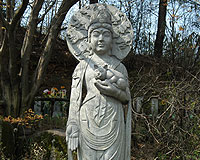  Dōbutsu Shūgō Kannon 動物集合観音 Dōbutsu Shūgō Kannon 動物集合観音
Also known as Dōbutsu Kannon. A modern form of Kannon devoted to the care of suffering animals, one granting eternal rest to pets, one invoked in prayers for deceased pets at pet cemeteries. (Keywords = 動物供養, ペット供養, 人形供養, ぬいぐるみ供養).
PHOTO: Dobutsu Kannon, Gifu Pref., Toki City
The modern-day use of Kannon as a patron of dead pets is not surprising. There are numerous antecedents. Batō Kannon (Horse-Headed Kannon), for example, an esoteric savior of those reborn in the realm of animals, was already well-known among the common folk in the Tokugawa period, when numerous farmers prayed to Batō Kannon for the safety and preservation of their horses and cattle. Innumerable stone steles of Batō Kannon were erected in the Tokugawa and Edo periods, for this deity was intimately connected with protecting dumb animals, particularly those who labored for mankind, and with protecting their spirits and bringing them ease and a happier life than they experienced while on earth.
Says scholar Mark R. Mullins in his article The Many Forms and Functions of Kannon in Japanese Religion and Culture: “Kannon has become a favorite comforting figure used by the numerous pet cemeteries that have been built across Japan over the past two decades. The Dobutsu Shugo Kannon is devoted to the care of suffering animals and offers eternal rest to the pets. Sanzen'in Temple in Toki City, Gifu Prefecture, one such example devoted to pets, explains that it offers pet owners ‘one last opportunity to express their love and gratitude’ through the services it offers. Another facility, the Meihan Pet Kannonji in Iga City, Mie Prefecture, was established in 1994, and provides similar services of cremation, a Kannon stone monument, and a priest conducting a memorial service. In addition to the services offered for pets at these specialized cemeteries and temples, it is also possible to purchase online a Pet Kannon for 12,600 yen (US$120), which has a standing image of Kannon with several pets at his/her feet. Charges for these services vary and depend on the size of the pet. Cats and small dogs cost thirty-five thousand yen [US$330], while a larger husky or golden retriever costs fifty-five thousand yen [US$520].” <end quote by Mullins>

|
|
COMMON ESOTERIC FORMS
WHAT IS ESOTERIC BUDDISM?
Esoteric Buddhism (Mikkyō 密教) is Japan’s version of Vajrayana (Tantric) Buddhism. Along with Hinayana and Mahayana Buddhism, Vajrayana is one of the three main schools of Buddhism practiced in Asia today. It is especially strong in Japan and Tibet. In Japan, the main esoteric sects are the Shingon 真言 and Tendai 天台 sects, both introduced to Japan from China in the early 9th century -- Japanese monk Saichō 最澄 (767-822 AD) founded Japan’s Tendai Sect, while his countryman monk Kūkai 空海 (774 - 835 AD), also known as Kōbō Daishi 弘法大師, founded the Shingon Sect. Both had visited China and brought back the teachings. All other forms of Buddhism are known as Exoteric Buddhism (Kenkyō 顕教), including Japan’s mainstream Zen sects and Pure Land Amida sects. The term Kenmitsu Bukkyō 顕密仏教 refers to both exoteric 顕 and esoteric 密 traditions. Esoteric artwork is exemplified by mandala paintings and by statues of wrathful deities with multiple heads and arms, particularly the Myō-ō 明王, who serve Dainichi Buddha (Skt. = Mahavairocana), the central deity of Japan’s esoteric sects. Nearly all Buddhist deities come in both esoteric and in exoteric forms.
Esoteric Buddhism’s main claim is that it enables a person to attain enlightenment in a single lifetime -- rather than passing through countless lives before achieving salvation (this is an over-simplification !!). To achieve this, it incorporates mystical visualizations, myriad symbols and deities, and complicated secret rituals that can only be learned by study with a master -- thus explaining the term “esoteric” Esoteric practice lays great emphasis on mantra (incantations), mudra (hand gestures) and mandala (diagrams of the deities and cosmic forces), as well as on magic and a multiplicity of deities.
|
|
 Esoteric Forms of Kannon in Japan Esoteric Forms of Kannon in Japan
Esoteric Buddhism originated in India sometime in the 6th century and then spread quickly throughout Asia. Avalokitêśvara (aka Kannon) was one of the first deities to be shown in esoteric forms in India and discussed in early esoteric texts. See, for example, Iconography of Amoghapāśa (Fukūkenjaku Kannon) by Ankur Barua and M.A. Basilio.
Esoteric Buddhism wasn’t formally introduced to Japan until the early 9th century (see adjacent sidebar), but various esoteric forms of Kannon had already entered Japan (via China) during the 7th century.
In Japan’s Taizōkai (Matrix) Mandala, Kannon appears in many esoteric forms in the Lotus Court (Rengebu-in 蓮華部院), which is also known as the Kannon Section (Kannon-in 観音院). For example, the six-armed Nyoirin Kannon appears here. This and other esoteric forms of Kannon belong to the Kannon family (Kannon-bu 観音部). See MANDALA pages for details.
SAYS JAANUS: By the mid-8th century, texts about esoteric Kannon were available in Japan. The first known text dealing with Jūichimen (11-Headed) Kannon is the Jūichimen-kyō 十一面経 (733). In 753 the Fukūkenjaku Shinpen Shingon-kyō 不空羂索神変真言経, a major esoteric text that speaks of Dainichi Nyorai 大日如来 and first mentions Fudō Myō-ō 不動明王, enters Japanese records. Texts concerning Senju (1000-Armed) Kannon 千手観音, Nyoirin (Omnipotent) Kannon 如意輪観音 and Batō (Horse-Headed) Kannon 馬頭観音 date from the same time. Images of Kannon were made as part of Emperor Shōmu's 聖武 (701-56) effort to impose Buddhist structure on Japan. Temples dedicated to Kannon were founded, many following the apparition of the deity or the miraculous appearance of an image. A temple dedicated to Kannon was often built in a mountain, beside a rock formation, near a spring, or near some other remarkable landscape feature, suggesting that the site was already sacred and was adapted to Buddhist use. Stories of such images and temples abound among engi 縁起 (origin stories) and setsuwa 説話 (religious stories), and they found expression in accompanying paintings (shaji engi-e 社寺縁起絵). The mountain temples particularly were considered sites of Kannon's paradise Fudaraku, fully Japanizing the deity, just as Putoshan 普陀山 in Zhejiang had been revered in China. Varieties of practice connected with belief in Kannon (Kannon Shinkou 観音信仰) were introduced, including the practice of group confession. <end JAANUS quote>

Female or Male? Feminized Forms of Kannon
 In Japan, four of the most common feminized forms of Kannon, all related to motherhood, are Koyasu Kannon 子安観音 (safe childbirth), Juntei Kannon 准胝観音 (pure one, mother of all Buddhist divinities), Jibo Kannon 慈母観音 (loving mother), and Mizuko Kuyō Kannon 水子供養観音 (patron of departed souls, especially children lost to miscarriage, stillbirth, or abortion). These four are today venerated as patrons of easy delivery and child rearing. See Patrons of Motherhood for other deities associated with women and children. Other female forms of Kannon include the Fish-Basket Kannon and the White-Robed Kannon. There is also Maria Kannon, a Christianized form used by outlawed Christians to hide their faith. In Western nations, Kannon is most commonly known as the “Goddess of Mercy.” In Japan, four of the most common feminized forms of Kannon, all related to motherhood, are Koyasu Kannon 子安観音 (safe childbirth), Juntei Kannon 准胝観音 (pure one, mother of all Buddhist divinities), Jibo Kannon 慈母観音 (loving mother), and Mizuko Kuyō Kannon 水子供養観音 (patron of departed souls, especially children lost to miscarriage, stillbirth, or abortion). These four are today venerated as patrons of easy delivery and child rearing. See Patrons of Motherhood for other deities associated with women and children. Other female forms of Kannon include the Fish-Basket Kannon and the White-Robed Kannon. There is also Maria Kannon, a Christianized form used by outlawed Christians to hide their faith. In Western nations, Kannon is most commonly known as the “Goddess of Mercy.”
The Male Goddess?
Kannon is considered male in the Buddhist traditions of India, Tibet, and Southeast Asia. But in China and Japan (less so in Japan), starting around the 11th - 12th centuries, Kannon was commonly portrayed as female (for reasons not easily explained or understood). In Japan, the male form predominates in sculpture and art, although female manifestations of Kannon are nonetheless plentiful. Indeed, a persistent femininity clings to Kannon imagery in both pre-modern and modern Japan.
In Japan, Kannon’s identification with the needs of women, mothers, and children emerged in the Heian period (9th to 12th centuries) with the growing popularity of the Lotus Sutra 法華経 (Hokekyō), one of the most beloved Mahayana scriptures throughout Asia owing to its message that anyone, whether male or female, could attain Buddhahood. The 25th chapter is popularly called the Kannon Sutra (Jp. Kannon-kyō 觀音経) and often treated as an independent text. In orthodox Buddhism, only males could achieve Buddhahood -- females could not unless they were first reborn into manhood (a higher state in the cycle of transmigration). In Japan, this transformation is known as Henjō Nanshi (変成男子), or "changing into a man." It was one of the five obstacles (Jp. = Goshō 五障) to enlightenment, and according to orthodox Buddhist texts all Buddha vow to change all pious women into men. This teaching lost much of its bite with the widespread popularity of the Lotus Sutra among women of the Japanese court during the Heian period. In the 12th chapter (Devadatta) of the Lotus Sutra, the daughter of Dragon King Sagara attains enlightenment at the young age of eight, illustrating the universal possibility of Buddhahood for both men and women. Japanese ladies of the Heian court thus turned to the worship of the Lotus Sutra to ensure their salvation. The Lotus Sutra also said Kannon could assume any form whatsoever to relieve suffering (see 33 Forms of Kannon). It also attributed Kannon with the power to grant children.
Kannon’s feminine forms in Japan are clearly compatible with Japanese religious sensibilities. Unlike Buddhism, whose deities are generally genderless or male, Japan’s Shintō tradition has long revered the female element. The emperor of Japan, even today, claims direct decent from Amaterasu (the supreme Shintō Sun Goddess), so it seems only natural that Kannon was given feminine attributes. Says scholar John Nelson: “Kannon has been so widely dispersed in Japanese culture, like the air one breathes, she has become part of the social and cultural landscape in ways that transcend sectarian doctrine." Nelson also says: “Perhaps we are limiting the possibilities by thinking of Kannon as a specifically Buddhist deity. Surely it makes as much sense in the context of the Japanese religious culture to see her role as similar to that of a Shinto kami -- specific to the situations of any place and its people, and attentive to sincere petitions." <end Nelson quote>In Shintō art (Shintō Bijutsu 神道美術), Jūichimen Kannon is a common choice as the Honjibutsu 本地仏 (Buddhist counterpart) of female Shintō deities (kami 神). Indeed, Jūichimen Kannon is one of the two most common choices as Honjibutsu to Shintō Sun Goddess Amaterasu 天照 (the other is Dainichi Buddha).
As the teachings of the Lotus Sutra gained a wider audience in both China and Japan, effigies of Kannon in female form began appearing with regularity (those associated closely with the virtues of compassion, gentleness, purity of heart, and motherhood). Extant statuary offers compelling evidence of this sex change. In early Japanese Buddhism, the concept of venerating a female statue would have been unthinkable. But by the 11th or 12th century, in both China and Japan, statues of Kannon clearly portray the male deity as female. Note: Among Buddhist art historians, gender is not typically an issue. Statues are primarily portrayed as asexual or genderless. The artisans of Japan's classical Buddhist statuary carved the faces, bodies, and robes (drapery) in ways that transcended male and female forms, in ways that avoided stressing a male persona. Nonetheless, the orthodox view (much weakened) is that all Buddha and Bodhisattva are male. One indication -- many Buddhist statues in Japan sport mustaches. I have long wondered why old statues, clearly feminine in form, are portrayed with a mustache. Apparently, this was intentional and meant to emphasize the absence of sexual identity. If you click the image of Senju Kanno shown at the right, a close look will reveal the “goddess” has a mustache.
Much later, in the mid-17th century, outlawed Japanese Christians (mostly in the Nagasaki area) created statues of the Virgin Mary (Mother of Jesus) disguised as the Buddhist deity Kannon (Goddess of Mercy). These images, called Maria Kannon マリア観音, were made or altered to look like Kannon, but they were not worshipped as Kannon. A Christian cross was sometimes hidden within the image. This did not arouse much suspicion, for Kannon (as described in Buddhist scripture) can appear in many different forms, both male and female.

|
補陀 or 補陀落山
Fuda or Fudarakusen or Fudarakusan
Also written 普陀, 布落迦山, 布呾洛加, 補陁,
補陀落, 補陀落迦, 補憺落迦, 補但落迦,
逋多, 逋多羅, 光明山, 海鳥山, 小花樹山
Sanskrit = Potalaka, Potala
Chinese = Bǔtuó, Pu-t'o
Korean = Bota 보타
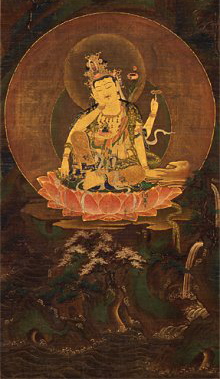
Painting of Nyoirin Kannon sitting
atop island paradise Fudaraku.
14th century. Important Cultural Property.
H = 102.1cm, W = 41.5 cm
Photo: Nara National Museum (J-Site)
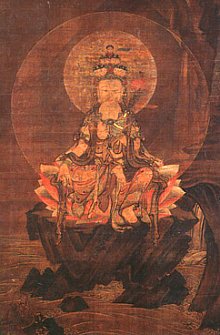
Painting of 11-Headed Kannon Bosatsu
sitting atop island paradise Fudaraku.
Mid Muromachi Era, H = 104.5 cm, W = 53 cm
Treasure of Mitsuzō-in Temple 密蔵院
Kasugai City, Aichi Pref., Photo: This J-Site.
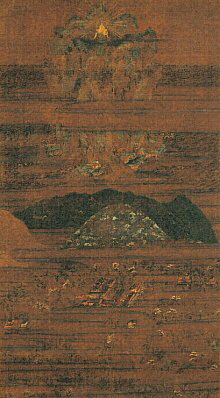
Kasuga Fudarakusen Mandala
春日補陀落山曼荼羅図
11-Headed Kannon and Mt. Fudaraku
depicted in upper portion. Kasuga Shrine
depicted in lower portion. Kamakura period.
Important Cultural Property. Nezu Museum
(Tokyo). Photo this J-Site
|
|
 Fudarakusen 補陀落山 Fudarakusen 補陀落山
In Japan, Kannon's paradise is known as Fudarakusen (or Fudarakusan), literally “Mt. Fudaraku.” Fudaraku is the Japanese transliteration of Sanskrit Potalaka. It is commonly thought to be an island-mountain paradise located near the southern tip of India, which suggests that Kannon originated in southern India. In Japanese statuary and painting, Kannon is sometimes shown sitting atop an octagonal island-mountain or atop a rock. This is meant to symbolize the Fudarakusen holy land.
Says the Digitial Dictionary of Buddhism about Kannon’s paradise:
- A sea-port on the Indus, the παταλα of the ancients, identified by some with Thaṭtha, said to be the ancient home of Śākyamuni's ancestors.
- A mountain south-east of Malakūṭa, reputed as the home of Avalokitêśvara.
- The island of Pu-t'o 普陀山, east of Ningpo, the Avalokitêśvara centre (in China).
- The Lhasa Potala in Tibet; the seat of the Dalai Lama, an incarnation of Avalokitêśvara; Transliteration of the Sanskrit Potalaka. Although the mountain is thought to be mythical, Xuánzàng (602-664 AD; a noted translator of Sanskrit into Chinese) attempts to locate it at the southern end of the Indian subcontinent in his Record of Travels to Western Lands 大唐西域記 (Jp. = Dai tōsaiikiki). Outside India, the name of Potala / Potalaka came to be used widely to indicate Avalokitêśvara's sacred space. This is also the traditional mountain residence of (Skt.) Potala Bodhisattva.
<Sources: C Muller’s Digitial Dictionary of Buddhism and Soothill>
The Kegon-kyō 華厳経 (Skt. = Avatamsaka Sutra; Flower Garland Sutra) and various other early texts refer to Kannon's paradise as a verdant land of bliss located somewhere in the southern oceans near India. The Kegon-kyō was first translated into Chinese around 420 AD, with a second translation around 699. The teachings and texts of the Kegon school were introduced to Japan around +736 by the Chinese monk Tao Hsuan, and helped spark belief in Kannon’s Fudaraku paradise.
Many old holy mountain sites associated with Kannon and Fudaraku exist in both China and Japan -- in particular Mt. Bǔtuó 普陀山 on the Chinese isles of Zhou-shan 舟山群嶋 (Jp. = Shūzanrettō) and amidst Japan’s sacred Kumano 熊野 mountain range. For a list of Japanese sites associated with Fudaraku, see Wikipedia (J-Site only). In addition, various Japanese religious ceremonies devoted to Kannon require pratitioners to face south while making supplications (need to give example).
Says JAANUS: “Faith in the Fudaraku paradise in Japan is illustrated in paintings known as Fudaraku Raigō-zu 補陀落来迎図, which show Kannon coming to welcome believers to Fudarakusen. The island of Potala is the chief center of Avalokitêśvara worship, where s/he is the protector of all in distress, especially of those who go to sea.”
For more on Fudaraku, see Temple Myths and the Popularization of Kannon Pilgrimage in Japan, by Mark W. MacWilliams. Japanese Journal of Religious Studies, 1997 24/3-4. Writes MacWilliams:
- "In Japan, the belief that temple sites either resembled or actually were Fudaraku was widespread. One of the earliest of these was Nachi-dera (Seiganto-ji 序渡寺), the first temple of the Saikoku Kannon pilgrimage in the twelfth century (page 388).”
- “As the eastern gate of Kannon's paradise throughout the later medieval period, Nachi-dera served as point of disembarkation for the many boat crossings (tokai 渡海)to Mount Fudaraku. Fudaraku Shinkō [faith] spread to the Kanto area with the migration of Shugendō mountain Buddhist ascetics from both the Honzan and Tōzan branches of Shugendō, who were centered in the Kinai region (page 388).”
- “Fudaraku itself has rich symbolic associations etymologically, mythically, and ritually with boats (page 389)."
Although MacWilliams (see above) mentions that Nachi-dera served as the point of disembarkation for the boat crossing to Mt. Fudaraku, longtime Japan-based scholar John Dougill believes this is wrong. Instead, says Dougill, "the nearby temple of Fudarakusan-ji 補陀洛山寺 was the actual place where people departed by boat for the southern seas, never to return. There is a noticeboard at the temple saying that twenty boats departed from here between the Heian and Edo periods. The monks who set off on these suicide missions apparently carried petitions from others to deliver to Fudaraku." <end quote> See Dougill's report here. Dougill adds this: “Was Fudarakusan-ji actually a part of the Nachi-dera complex in former times? To find out, I phoned the head priest at Fudarakusan-ji, who told me the temple is an independent entity. In bygone days, it was the head monk of Fudarakusan-ji who sailed away in the boat when he reached the age of sixty. Fudarakusan-ji, according to the monk, has nothing formally to do with Nachi-dera (aka Nachi Taisha, aka Seiganto-ji).” <end quote>
Fudarakusan-ji was awarded UNESCO World Heritage status in 2004. The boat journey (in a vessel called Tokaibune 渡海船 or “boat to cross the sea”) was a form of self-sacrifice aimed at the salvation of the common people. According to the Fudarakusan-ji entry at SacredJapan.com, "the abbots of this temple set out to sea on a small rudderless boat when they turned sixty years old. This practice was called Fudaraku Tokai 補陀洛渡海 and is one of the Shashin Gyō 捨身行 trainings in which priests performed an act of self-sacrifice for the purpose of human salvation. People entrusted the priests to carry their prayers for happiness and enlightenment to Fudaraku (Potala in Sanskrit) Island, Kannon's Paradise, which was said to lie somewhere off the southern coast." <end quote>
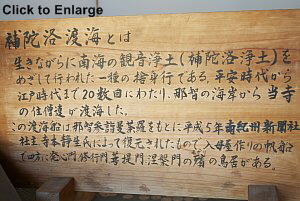 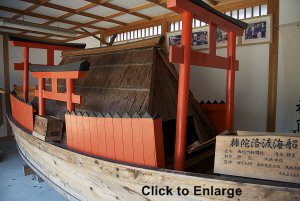
(L) Noticeboard at Fudarakusan-ji says twenty boats departed from here between the Heian and Edo periods.
(R) Replica of the boat -- Tokaibune 渡海船 -- used on the journey to Fudaraku. Photos courtesy John Dougill.
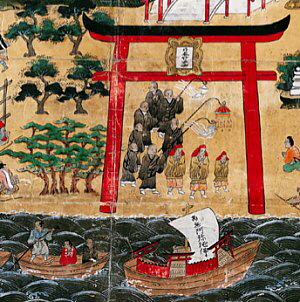 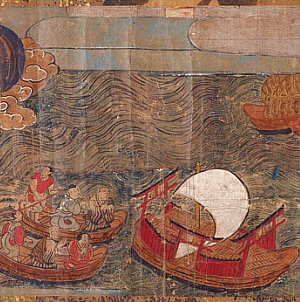
ABOVE: Artwork of the boat departing for Kannon's holy land appears in mandala known as Nachi Pilgrimage Mandala (Nachisankei Mandala 那智参詣曼荼羅). Two extant examples from the early Edo period are shown above. Click either image to see the complete mandala and/or enlarged sectional scans. Images from the Kokugakuin University.

|
|
Fukūkenjaku, or Fukūkensaku
Also known as Fukūkenjaku Bosatsu
Sanskrit = Amoghapāśa
Chinese = Bùkōng Juànsuǒ Guānyīn
Korean = Bulgong Gyeonsak Gwaneum
불공견삭관음
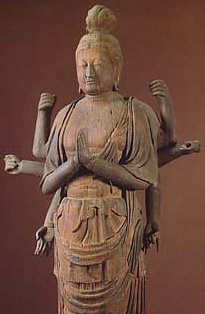
Fukūkenjaku, Late Nara period.
Daianji Temple 大安寺. Wood.
H = 189.9 cm. Important Cultural Property.
Objects held in the various
hands no longer extant.
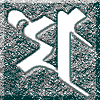
Sanskrit Seed
Pronounced BO ボ in Japan
Shingon Mantra (ご真言)
おん あぼきゃはらちかた うんうんはった そわか
On Abokyaharachikata Ununhatta Sowaka
|
|
|
|
|
Fukūkenjaku Kannon 不空羂索観音
Lit. = "Never-Empty Lasso" or “Never-Empty Rope,” or “Unfailing Net.” An esoteric form of Kannon. Considered one of the Six Kannon by followers of the Tendai sect. The exact origins of Fukūkenjaku are unclear. The earliest known information on this deity comes from the late 6th-century Chinese translation of the Amoghapāśahṛdaya Mahāyāna Sūtra. Extant artwork tells us that worship of this deity first started in India, and then spread to Nepal, Tibet, China, and Japan in the later part of the eighth century.
Fukūkenjaku means "never empty lasso," which refers to the coil of rope the deity holds in one of the arms. Fukūkenjaku uses this rope to catch straying souls and lead them to salvation. The lasso (noose) is found in other multi-armed forms of Kannon as well, and is said to bind attachment rather than catch straying souls. The hands also hold other objects (which can vary), including a net (to catch straying souls), lotus, halberd, trident, pilgrim’s staff, and wish-granting jewel (cintāmaṇi); in Japan and Nepal, extant images sometimes show the deity draped in a cloth (representing a deer skin).
The earliest representation of Fukūkenjaku in Japan is installed at Tōdaiji Temple 東大寺 in Nara. Dated to 746-748 AD, this dry lacquer statue stands 12 feet high (see photo below), and is flanked by attendants Nikko and Gakko Bosatsu (Nikko to right of main statue and Gakko to left). This statue of Fukūkenjaku is depicted with eight arms, the most popular form in Japan, and three eyes, but other forms exist, including those with four arms (the most common form in India), six arms, or ten arms; sometimes also represented with three heads, especially in Tibet.
Another early image of Fukūkenjaku in Japan is located at Daianji Temple 大安寺 in Nara, also eight-armed, and dated to last half of the 8th century. See adjacent photo.
Other Resources
|
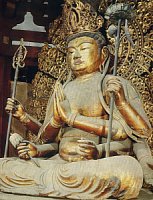
Fukūkenjaku Kannon
by Kōkei, dated +1189.
Wood, lacquer & gold leaf
H = 348 cm, Kōfukuji 興福寺 Temple, Nara. Photo from
Heibonsha Survey, Vol. 11
|
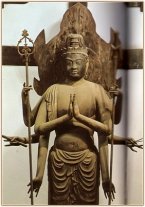
Fukūkensaku Kannon
8th to 9th Century
Kōryū-ji Temple
|
|
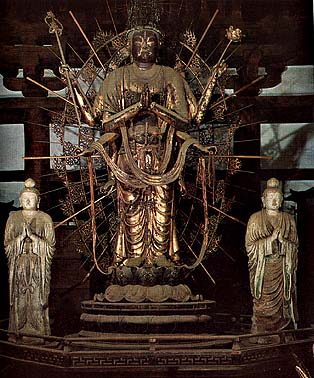
Fukūkenjaku Kannon 不空羂索観音 (H = 3.62 meters,)
Flanked by Nikko (right) and Gakko (left)
with hands in the Gassho mudra (prayer, veneration).
746-748 AD, Dry Lacquer, Tōdaiji Temple 東大寺 (Nara)
Photo courtesy www.art-and-archaeology.com
|
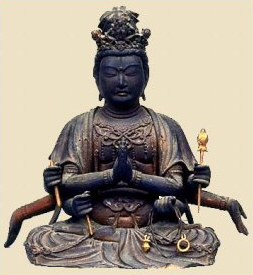
Four-Armed Fukūkenjaku Kannon
“Never Empty Lasso”
Kamakura Era, Wood
Courtesy Kyoto National Museum
Lasso in hand to catch straying souls
and lead them to salvation.
Usually depicted
with eight arms in Japan.
|
|

Fure-ai Kannon, Fure Ai Kannon ふれ愛観音 or ふれあい観音
Statues of Kannon that are meant to be touched or rubbed. The Japanese term Fure ふれ means to touch or interact with or pet. Says site contributor Gabi Greve: “Since most Buddha statues are in temples or museums, you are not supposed to touch them. But for blind people, there is no way to SEE what they are. So Nishimura Kōchō 西村公朝 (1915-2003), a famous modern sculptor, carved a Kannon Statue and put in up in his temple, where anybody could come and touch it. This became so popular that within a few years many other temples put up this kind of "touchable Kannon." In Japanese, there is a play on words as well, for AI 愛 is the character for “love.” <end quote>
There are other examples of the “touch me” variety. Many statues of Daikoku (one of Japan’s Seven Lucky Gods and a popular deity of agriculture and success in worldly endeavors) appear worn near the head and shoulders, as devotees believe that rubbing their hands on this god will somehow bring them luck (i.e., that good luck will rub off on them). This popular local belief may be an extension of “rubbing” traditions involving statues of Binzuru (the most widely revered of the Arhat in Japan) and Yakushi Nyorai (the Buddha of Medicine and Healing). Statues of these deities are usually well worn, as the faithful rub part of the statue (knees, back, head), then rub the same part of their body, praying for the deity to heal their sickness (e.g., cancer, arthritis, headaches, other ailments). Both are reputed to have the gift of healing. The “rubbing” tradition associated with Daikoku could thus suggest that Daikoku too possesses the gift of healing. I do not know how or when these “rubbing” traditions emerged.

Guze Kannon, or Kuse Kannon 救世観音
 Another name for Shō-Kannon 聖観音, one referring to the simple (non-esoteric) form of Kannon. Although the term “Guze” (lit. = salvation) is not specifically given as a name for Kannon in Buddhist texts, it does appear in a phrase in the Lotus Sutra (Hokekyō 法華経) -- a phrase that describes Kannon's powers to save people from suffering. Japan’s most famous Guze statue is installed at Hōryū-ji Temple 法隆寺 in Nara. Also called the Yumedono Kannon 夢殿観音, this standing image of Kannon was reportedly made in the image of Prince Shōtoku Taishi 聖徳太子 (574-622). Other important Guze statues are located at Sanzen-in 三千院 in Kyoto (see photo below) and Shitennōji 四天王寺 in Osaka, but they deviate from the normal forms of Shō Kannon, and portray the deity sitting in the hankazō 半跏像 (half-cross-legged) position. Another name for Shō-Kannon 聖観音, one referring to the simple (non-esoteric) form of Kannon. Although the term “Guze” (lit. = salvation) is not specifically given as a name for Kannon in Buddhist texts, it does appear in a phrase in the Lotus Sutra (Hokekyō 法華経) -- a phrase that describes Kannon's powers to save people from suffering. Japan’s most famous Guze statue is installed at Hōryū-ji Temple 法隆寺 in Nara. Also called the Yumedono Kannon 夢殿観音, this standing image of Kannon was reportedly made in the image of Prince Shōtoku Taishi 聖徳太子 (574-622). Other important Guze statues are located at Sanzen-in 三千院 in Kyoto (see photo below) and Shitennōji 四天王寺 in Osaka, but they deviate from the normal forms of Shō Kannon, and portray the deity sitting in the hankazō 半跏像 (half-cross-legged) position.
PHOTOS AT RIGHT
Guze Kannon 救世観音 (Guse, Kuze, Kuse)
Also called Yumedono Kannon 夢殿観音
Reportedly made in the image of Prince Shōtoku Taishi
Hōryū-jiTemple 法隆寺 (Nara)
7th Century (621 AD or so), Height = 178.8 cm
This is the earliest extant wooden statue in Japan (first half 7th century). Carved from one piece of camphor 樟 wood (Kusu), in the style of those times. Gold leaf is applied over the surface, and the coronet and other details are made from gilt bronze. The effigy is the non-esoteric form of Kannon, as Esoteric Buddhism (Mikkyō 密教) was not formally introduced to Japan until the 9th century. Guze is also a name used for sculptures of the Asuka period, specifically for sculptures of a crowned Bodhisattva (Bosatsu) holding a jewel.
This statue was kept hidden for centuries inside the Yumedono Hall 夢殿 at Hōryūji Temple -- even the priests were forbidden from viewing the statue, which was wrapped in some 500 yards of white cloth and stored in a black lacquer case. The practice of maintaining Secret Buddha (Jp. = Hibutsu 秘仏) most likely originated among Japan’s esoteric sects (Shingon & Tendai) during the Heian period. The statue was finally unveiled in 1884, when the Japanese government allowed Ernest Fenollosa (1853-1908) and Okakura Tenshin 岡倉天心 (1863-1913) to discover its secrets. Fenollosa thought it to be of Korean origin, but no consensus was ever reached. Some think it displays the style of Japan’s Tori school of Buddhist sculptors who originally emigrated to Japan from Korea. Today it is considered to be one of Japan's greatest art treasures for this period. It still remains a HIBUTSU at the temple, but for a small time every spring and fall it is open for viewing. <See JAANUS for more details on Guze Kannon>
GUZE KANNON MYSTERY?
Below text by Henry Smith at Columbia University
From “Prince Shōtoku’s Temple, The Riddles of Hōryūji”
Editor’s Note: A wonderful presentation, highly recommended.
Prince Shōtoku was, after all, like Shakyamuni (the Historical Buddha), a royal prince who renounced his inheritance in pursuit of spiritual ideals. Following Shōtoku's death in + 622, his family continued to patronize Hōryūji Temple until 643, when his son and heir, Prince Yamashiro Ōe no Ō 山背大兄王 (Yamashiro Ōji 山背王子 for short), was forced to commit suicide by the Soga clan leader, who was fearful of the threat that Yamashiro posed to Soga power. With this, the direct line of Prince Shōtoku came to an end. The temple survived, however, in close association with the memory of Shōtoku. But as far as we can tell, the Yumedono Kannon was never seen by anyone from the time of its consecration in the eighth century until 1884, when an inquisitive American scholar named Ernest Fenollosa managed to unwrap it. Fenollosa survived the catastrophe predicted by the priests of Hōryūji, but even today, the Yumedono Kannon is on public view for only a few weeks every year.
Centuries of oral tradition confirm what you have probably already suspected, that this image is in fact a representation of Prince Shōtoku, now transformed into a saving Kannon. This association probably explains some very curious features of the statue. To begin with, the hands are overly large, and reach sensuously around what you may recall from the rooftop ornament: another reliquary, in effect, Prince Shōtoku seems to be holding his own remains. The face is equally unique, featuring a wide nose, prominent lips, and very narrow eyes, all said to be personal attributes of the prince himself.
But there is a very different school of thought which sees the smile as oriented outward, a sinister leer which threatens more than it saves, particularly when seen from below as the normal worshipper might. This has led to the eerie interpretation that the Yumedono Kannon is not a gentle and grace-giving Kannon, but rather the restless angry ghost of Prince Shōtoku himself. In support of such a theory consider a comparison between the Yumedono Kannon and the famous Kudara Kannon statue (also found at Hōryūji). The point of the comparison lies in the haloes. Whereas the halo of the Kudara Kannon is supported by a slender bamboo pole, that of the Yumedono Kannon is attached by a large nail driven into the back of the head. This highly unusual method of attachment, it is argued, is just like the voodoo technique of sticking pins in dolls, an effort to subdue the spirit of Prince Shōtoku rather than save it. This might also help explain why the image was kept wrapped up for so many centuries. The remaining mystery, however, is why the revered Prince Shōtoku should be so angry. The most persuasive theory is that his ghost was angered by the termination of his family line in + 643, when his son was forced to suicide by the Soga clan leader. <end quote from Henry Smith at Columbia University>

 Gyoran Kannon 魚籃観音 Gyoran Kannon 魚籃観音
Literally “Kannon with Fish Basket.” Chn. = Yulan Guanyin. One of 33 Forms of Kannon. In China, her images begin to appear frequently in 15th-century encyclopedias and scroll paintings. In Japanese artwork, Gyoran is typically depicted holding a fishing basket or standing atop a fish, which symbolize her role as the patron of maritime safety and good fishing. She is associated with a Tang-era Chinese tale (with many variations) about a young and attractive woman who appears as a fishmonger (carrying a basket full of fresh and shiny fish) to aid a riverside market town beset by a nasty dragon who, each day, makes giant waves to capsize the boats of merchants and shoppers. After selling all her fish, she tells the townsmen she will marry the man who can toss the most money into her empty basket. However, all coins that miss the basket, she says, will be used to build a bridge, so all can cross safely over the raging river. The men, blinded by her beauty and their own sexual desire, tossed their coins poorly -- not one landed in the basket.
This Chinese tale, variations of it, and other stories about the Fish Basket goddess portray her, in varying degrees, as a seductress, one who uses the bait of sexuality or promise of marriage to enlighten men. In the end, however, she remains a virgin. Her imagery as seductress is a didactic tool to help people overcome their sexual lust and break free of sexual desire. Says scholar Jeong Eun Kim: "The themes of fish and fish basket, however, seem not to be crucial elements in depicting Yulan Guanyin as a seductress." <see footnote 24 of Jeong's study> Also, says independent scholar Wayne Woo of Singapore: "The great koi fish in her imagery is a symbol of majesty that awes the raksas, nagas, and demons into submission, and the basket is where they are contained.”
In modern Japan, the Fish-Basket story appears to have been stripped of its seductress theme. Says Gabi Greve: “The story of Fish Basket Kannon originated in T'ang-era China (618 - 907 AD) and is about a girl selling fish on the market. She asked Kannon to grant her wish for a good husband. The wish was granted and later the girl herself was considered an incarnation of Kannon. In modern Japan, Gyoran Kannon is the protector deity of young men looking for a bride.”
|
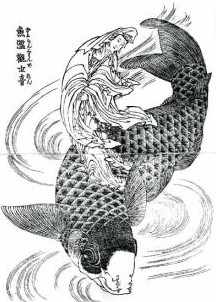
|
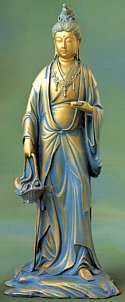
|
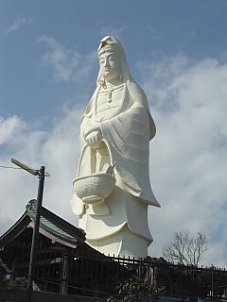
|
|
Gyoran Kannon
Painting by Hokusai Katsushika
北斎葛飾 (1760–1849)
Photo this J-site.
|
Gyoran Kannon
Modern Statue
Photo this J-site.
|
Dai (Big) Gyoran Kannon 大魚籃観音
Tōzen-in Temple 東善院
Odawara City, Kanagawa Pref.
Built in 1982, H = 13 meters, Photo this J-site.
|
|
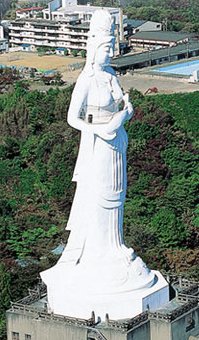
Big Kannon (Dai Kannon)
Kamaishi Daikannon, 釜石大観音
Height = 48.5 meters.
Kamaishi City, Iwate Prefecture
|
Big Kannon of Kamaishi City (Iwate Pref.). Known as the Kamaishi Daikannon 釜石大観音, this 48.5 meter statue was built in 1970. The statue is a modern version of the Gyoran Kannon (Bodhisattva of mariners and fishing), and befittingly holds a large fish in its hands. Visitors can climb inside the 13-story statue (with 204 stairs) and enjoy various galleries of Buddhist art and scenic vistas of the surrounding bay area. Kamaishi City was Japan's first municipality to pursue manufacturing with iron blast furnaces -- the town's name, Kamaishi 釜石, literally means "Iron Town."
External Links:
|
|

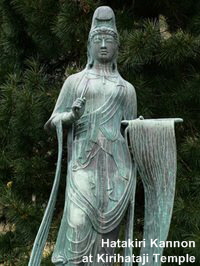  Hatakiri Kannon 幡切観音 Hatakiri Kannon 幡切観音
Cloth-Ripping Kannon. The 88-Temple Pilgrimage on Shikoku Island (Japan) is still a popular pilgrimage today. Temple number ten, Kirihata-ji Temple 切幡寺, located on Mt. Tokudozan 得度山, is associated with a very curious legend involving Kannon Bodhisattva. This temple venerates a manifestation of Kannon named Hatakiri Kannon 幡切観音 (cloth-ripping Kannon). Says longtime site contributor Gabi Greve:
Once upon a time, at the bottom of Mt. Tokudozan, there lived a young girl who made a living by weaving cloth. One day, a poor priest came along and asked her for a piece of cloth. Without further ado, she cut in half the cloth she was working on and gave one piece to the priest. The girl's father had been banished to a faraway island, although he had not committed any crime. The girl's mother, who was pregnant when this happened, came to the mountain to give birth to the daughter, but died without being able to fulfill her wish of praying properly to the Holy Kannon. So the priest carved a statue of the Holy Kannon with a piece of cloth over her arm and gave it to the girl to pray to every day. The girl then transformed herself, sending out seven layers of light, and transformed into the Holy Kannon. As you might guess, the priest was no other than Kobo Daishi (774 - 835 AD), the founder of Japan’s esoteric sect of Shingon Buddhism as well as the founder of the 88-Temple Pilgrimage in Shikoku. Another version of the story goes like this: Kobo Daishi founded Kirihata-ji Temple in honor of a beautiful young girl. Every day, while he performed his meditations in a mountainside hut, she interrupted her cloth-weaving -- kirihata means "cutting cloth" -- to bring him food. Eventually, she told him her story. Her mother had been a lady of the court in Kyoto and her father an officer in the court guard. Before she was born, her father had been exiled for his part in a rebellion and her mother, fearful of the danger to her unborn child, prayed to Kannon, the Buddha of compassion. Her prayers were answered and she managed to flee to Shikoku island where she raised her child until she died, leaving the daughter alone. Kobo Daishi was so moved that he carved her a statue of Kannon and, heeding the girl's wishes, ordained her as a nun. She immediately attained enlightenment, or Buddhahood, and changed into a statue of Kannon joining the one Kobo Daishi had carved. Kobo Daishi took the two statues and enshrined them in the temple he built in the girl's honor. <end text from Gabi Greve >
These two legends share common elements with an even earlier tale. Says JAANUS:
Scholars believe that the original Taima Mandara was a large-scale embroidery imported from Tang China (618 - 906 AD). It is believed that in 763 AD, during Japan's Nara period, the devote Buddhist nun Chuujou Hime 中将姫 had it woven with lotus threads (Gūshi 藕糸) based on a vision she had experienced. Thus the original woven work is sometimes also called the Gūshi Mandara 藕糸曼荼羅. The miraculous weaving of the 4.5 meters square tsuzure-ori 綴織, usually translated as "figured (hand woven) brocade," is said to have been accomplished by this nun, who was believed to be a human incarnation of Kannon Bodhisattva, the main attendant to Amida. This 8th-century work is still preserved today at Taimadera 當麻寺 (Taima Temple) in fragments with a great many Kamakura period repairs. From the Heian period (10th century), with the increasing popularity of Pure Land beliefs, the work grew ever more revered. In the Kamakura period Hounen's 法然 (1133-1212) disciple Shoukuu 証空 (1177-1247), founder of the Seizan 西山 branch of the Joudo sect (Joudoshuu 浄土宗), actively propagated the teachings of the Taima Mandala (outside link). <end JAANUS quote >

Henge Kannon 変化観音
Literally “Kannon Transformations.” A general term for the many manifestations and supernatural forms assumed by Kannon. HENGE is also used to refer to animals and mythological creatures that can transform themselves into humans or other entities. See shape-shifters page for details. Says JAANUS: “Henge Kannon refers to the ’transformations’ in which Kannon appears in order to save sentient beings. The term is frequently used in Japanese scholarly writings to refer to any deities treated as forms of the manifestations of Kannon, except for Shō Kannon, the basic pure form of Kannon. The term may be used more narrowly to refer to the forms of Kannon (apart from Shō Kannon) that came to be worshipped in Japan before the formal introduction of the Tendai 天台 and Shingon 真言 sects of Esoteric Buddhism (Mikkyō 密教) in the early 9th century. It is commonly used to describe Kannon in supernatural forms (i.e. multiple arms and heads) such as Jūichimen Kannon (Eleven-headed Kannon), Senju Kannon (Thousand-armed Kannon), Fukūkenjaku Kannon, and Nyoirin Kannon, even though some of these have standard iconographic forms (one head, two arms) as well. The idea of transformation is associated with the idea of incarnations or avatars, such as Shōtoku Taishi (574-622) being considered an incarnation of Kannon (or of Shaka, the Historical Buddha), as well as with the idea of grouping deities in families and counting one deity as an emanation of another, according to which Kannon is considered an extention of Amida Buddha. <end JAANUS quote>

Hitokoto Kannon 一言観音
One-Prayer Kannon, or Kannon of a Single Utterance, or One-Word Kannon. This deity is worshipped at various locations throughout Japan, most notably at Kōfukuji Temple 興福寺 in Nara. The temple’s web site says this: “The Hitokoto Kannon Hall was relocated to its current location in the Meiji period. It houses a hidden image of Hitokoto Kannon, or ’Avalokitesvara of a Single Utterance.’ This name for Kannon is derived from the belief that if one sincerely recites Kannon's name, Kannon is sure to respond to the devotee’s prayer.”
The Shintō camp incorporates a similar deity named Hitokotonushi 一言主 (lit. = deity of one word), who is venerated at Katsuragi Hitokotonushi Jinja 葛城一言主神社, a shrine in Goseshi City 御所市, Nara Prefecture. Hitokotonushi appears in the Nihon Shoki 日本書紀 (Japan’s second oldest extant text, compiled around 720 AD). The kami only grants one-word requests or single requests from devotees. Others say the deity only utters one word of good or bad in his/her oracles. For more see Gabi Greve. In the Kojiki 古事記 (Japan's oldest surviving text, complied around 712 AD), the deity is known as Katsuragi no Hitokotonushi no Ōkami.
Says Matsunaga Naomichi at Kokugakuin University: “A god (kami) appearing on Mount Katsuragi, near the border of Yamato and Kawachi Provinces, and who could utter oracles of good or evil with the decisive speaking of a ’single word’ (hito-koto). The central deity (saijin) of the Hitokotonushi Shrine in Katsuragi, Katsurakami District, Yamato Province (present-day Nara Prefecture). According to the Kojiki, when Emperor Yūryaku Tennō 雄略天皇 (5th century AD) climbed Mount Katsuragi with his many courtiers, they encountered another troupe having identical appearance. Enraged, the emperor readied his arrow and asked for the names of those in the opposing group. The leader of the group responded, ‘I am Hitokotonushi no Kami of Katsuragi, who proclaims evil in a single word, good in a single word.’ Upon hearing this, the emperor and his courtiers removed their garments and offered them to the kami. Similar stories are found in the Nihongi and Shoku Nihongi; the version in the the Nihongi reflects ancient beliefs in hermetic mountain wizards.”

 Jibo Kannon 慈母観音 Jibo Kannon 慈母観音
Jibo 慈母 literally means "Compassionate Mother." Other common translations include Goddess of Motherly Love, Merciful Mother, or Affectionate Mother. A feminine form of Kannon often depicted as a white-robed woman holding a babe in her arms. This iconography reportedly originated in China in the 14th and 15th century, where the deity was known as Songzi Guanyin 送子観音 (Child-Giving Guanyin), but did not make its way to Japan until the Tokugawa Era 徳川時代 (+1615-1867), when it was appropriated by the outlawed Christians, who hid their faith by venerating the Virgin Mary disguised as a statue of Jibo Kannon. Such statues are known as Maria Kannon. Jibo Kannon is thus a relative latecomer to Japan's Buddhist pantheon.
Kentaro Miyazaki, a leading Japanese authority on Japan’s Hidden Christians (Kakure Kirishitan), says Maria Kannon statues were often white or blue porcelain figures (imported from China) of Koyasu Kannon or of Jibo Kannon holding a child. <See Kentaro Miyazaki, "The Kakure Kirishitan Tradition," in Handbook of Christianity in Japan, edited by Mark R. Mullins, Leiden, Netherlands: E. J. Brill, 2003, p. 28.>
According to Ruby Lane art dealers: "The Songzi Guanyin is a symbol of the 'Giver of Children' and the 'Dispenser of Fecundity.' Although women were viewed as significant in their role of providing offspring in China, they were isolated during events relating to bearing of children. This image of Guanyin became especially significant to women because she was all accepting, especially during times of isolation and because she is credited with assisting women in becoming pregnant, protecting women during childbirth, and protecting unborn and born children. Songzi Guanyin images evolved over the centuries. During the 14th through 16th centuries, Jesuit and Portuguese missionaries visited China, and, having witnessed the magnificent carvings of the Guanyins there, asked the carvers to render depictions of Madonna and Child images to send back to northern Europe. The Chinese carvers, being exposed to statues in which a child rested on the lap of an adoring mother figure, then began to depict Guanyin in this way as well. Thus, from the 14th century onward Songzi images displayed a blending of eastern and western cultures into a new iconographic form." <end quote> For more on Songzi, see The Creation of Goddess of Mercy from Avalokitesvara, a book project launched by the Indira Gandhi National Centre for the Arts, 1998, ISBN: 81-212-0585-9.
|
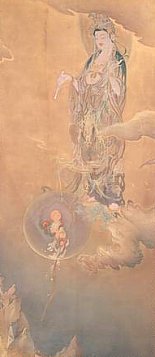
Jibo 慈母 Kannon
A widely known painting by
Kano Hogai 狩野芳崖 (1828-88).
Photo: Tokyo Univ. of the Arts
|
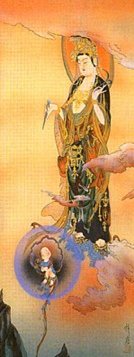
Jibo 慈母 Kannon
A modern reproduction of
the Kano Hogai painting.
(see left column).
|
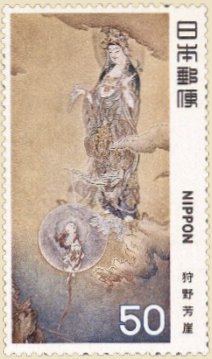
Jibo 慈母 Kannon
Kano Hogai’s painting
was even used as the theme
of a Japanese postage stamp.
|
|
Numerous giant effigies of Jibo have been erected in recent decades
|
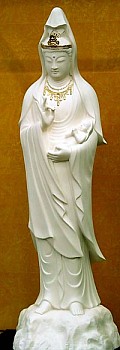
Jibo 慈母 Kannon
Loving Mother Kannon
Holding Babe in Arms
Modern Japanese Statue
Photo this J-site
|
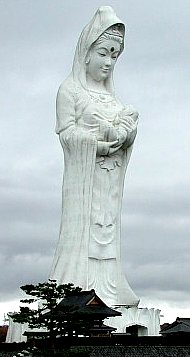
Jibo 慈母 Kannon
Loving Mother Kannon
Aizu, Fukushima Prefecture
H = 57 meters, Built in 1987
Photo courtesy this J-site
|
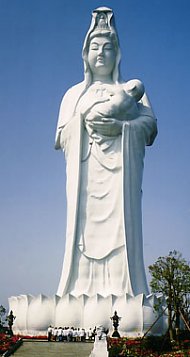
Guze Jibo Daikannon
救世慈母大観音様
H = 62 meters
Narita-san Temple 大本山 成田山
Kurume, Fukuoka Pref., Opened 1983
|
|

|
Juntei Kannon 准胝仏母
In Japan, also known as
Shichigutei Butsumo 七倶胝仏母
or Butsumo Juntei 仏母准胝.
Sanskrit = Cundi or Candī
Chinese = Zhǔntí
Korean = Junje 준제
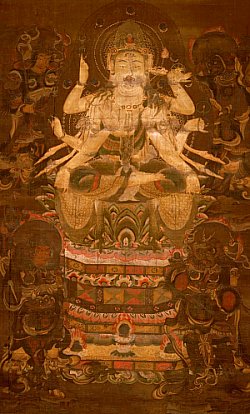
Juntei Kannon -- Painting
Heian Period, Courtesy Tokyo Nat’l Museum
1幅, 絹本着色, 縦103.4 横47.4, 平安時代
重文, A11796, 田中親美氏寄贈
Saves faithful from plague 除災
and blesses them with children 求児.
准胝観音を本尊として除災・
延命・求児などのために祈る修法

Sanskrit Seed
Pronounced SHU シュ in Japan
Shingon Mantra (ご真言)
おん しゃれいしゅれい そんでい そわか
On Shareishurei Sondei Sowaka
|
|
 Juntei Butsumo Kannon 准胝仏母 Juntei Butsumo Kannon 准胝仏母
Lit. = “Pure One (Juntei), Mother of the Buddhist Deities (Butsumo).” An esoteric form of Kannon who is considered the mother of the myriad Buddha and Bodhisattva. One of the Six Kannon.
Among the three Daigoji Temple 醍醐寺 (Kyoto) sects of the Ono Shingon branch 小野流 of Esoteric (Tantric) Buddhism, Juntei is considered a Bodhisattva and one of the Six Kannon (Roku Kannon 六観音). In the Hirosawa 広沢流 branch of Esoteric Shingon Buddhism, and in Tendai 天台 Buddhism, however, Juntei Butsumo is considered a Buddha.
Says JAANUS: “Juntei is a deity propitiated for wisdom, conjugal harmony, obtaining a child, long life, and rain. The most famous story is that of Shōbō 聖宝 (832-909), the founder of Daigoji Temple. His efforts reportedly led to the successful propitiation of Juntei for the birth of two emperors. The frequent association of the deity with prayers for conjugal harmony and children suggests a feminine nature, as does the name "butsumo." Juntei is often said to be female, but Japanese sculptures and paintings rarely depict a woman.”
JAANUS also reports that “Juntei's headdress does not always contain a small figure of Amida; Juntei does not appear in the Kannon section of the Matrix Mandala (Taizoukai Mandara 胎蔵界曼荼羅), but rather in the Henchi-in 編知院 section connected with wisdom; and Juntei is not listed as a name of Kannon in texts. Four-and six-armed images of Juntei dating from the 7th and 8th centuries are extant in the Ellora caves in India and in Borobudor in central Java, Indonesia (8-9c). No Chinese examples are known, but Juntei’s iconography is mentioned in texts such as the SHICHIGUTEI BUTSUMO JUNTEI DAIMYOUOU DARANIKYOU 七倶胝仏母准堤大明王陀羅尼経 translated by Vajrabodhi (Ch: Jingangzhi, Jp: Kongouchi 金剛智, 671-741) and SHICHIGUTEI BUTSUMO SHOSETSU JUNTEI DARANIKYOU 七倶胝仏母所説准胝陀羅尼経 translated by Amoghavajra (Ch: Bukong, Jp: Fukuu 不空, 705-74). These texts describe Juntei as yellow in color and with three eyes and 18 arms, and this is how Juntei appears in the Taizoukai Mandara. However, eight-armed forms appear in some of the most important compilations of Buddhist iconography in Japan including the KAKUZENSHOU 覚禅鈔 (13c) and extant examples of Juntei may have between two and 84 arms. Thus Juntei can be difficult to distinguish from Senju Kannon or Fukuukenjaku Kannon. Attributes of extant examples also vary in spite of the fact that in the original Chinese texts they are almost the same. Juntei may be shown with two dragon kings rising from the sea below the lotus throne. Since Juntei appears in the Henchi-in Section of the Matrix Mandala along with Butsugen Butsumo 仏眼仏母, and since "butsumo" is an epithet of Prajnaparamita (Hannya Bosatsu 般若菩薩), some connection with this deity and with the Prajnaparamita texts seems likely. It is often said that Juntei had a non-Buddhist origin and is related to Hindu deities.” < end JAANUS quote>
Says Soothill in his Dictionary of Chinese Buddhist Terms: In Brahmanic mythology a vindictive form of Durgā, or Pārvatī, wife of Śiva. But in China identified with Maricī 摩里支 or 天后 Queen of Heaven. She is represented with three eyes and eighteen arms; also as a form of Avalokitêśvara (Kannon) or in Avalokitêśvara's retinue. Also transliterated as 准胝; 尊提.
Also see Historical Evolution of Juntei Kannon and Child-Giving Koyasu 子安 Deities in Japanese Buddhismn by Louis Frederic, as quoted from “Buddhism: Flammarion Iconographic Guides.”

 Jūichimen Kannon 十一面観音 Jūichimen Kannon 十一面観音
Literally 11-Headed Kannon, or 11-Faced Kannon. One of the Six Kannon. This beloved esoteric (tantric) form of Kannon is depicted with eleven heads atop its crown. This iconography was introduced to Japan from China in the 7th century. There are various explanations for the eleven heads. On a folk level, some say it is symbolic of shedding sweetness and mercy in all directions, others that Kannon became so distressed after witnessing the sufferings of the world that his head split into eleven pieces. But the most plausible explanation is that the lower ten heads represent the Ten Stages of the Bodhisattva Path (steps required to attain enlightenment). The 11th head, located at the very center in the highest position, represents the 11th stage, Buddhahood, the final and ultimate result for those following the Bodhisattva Path. The 11th head, moreover, is identified as Amida Buddha, the central deity in Japan’s Pure Land sects -- for in these sects, Kannon is considered an active emanation of Amida.
There are other plausible explanations. According to the Kannon-kyō 觀音経 (the 25th chapter of the Lotus Sutra 法華経), Kannon constantly surveys the world listening for the sounds of suffering. Hearing these sounds of distress, the "Sound Observer" -- by virtue of unblemished knowledge, the powers of supernatural penetration, and expedient devices -- is able to display her/his body ’in the lands of all ten quarters.’ Kannon does so ’by resort to a variety of shapes,’ changing into the most suitable of thirty-three different forms for preaching the Dharma to save all who are suffer (HURVITZ 1976, p. 318). The mention of the "ten quarters" may be a clue to unraveling the mystery of why Kannon often appears (in artwork) with ten small Buddhist images in her/his headdress.
As one of the Six Kannon (Roku Kannon 六観音), Jūichimen is responsible for the salvation of those in the Ashura Realm (see Six Realms of Karmic Rebirth). Jūichimen is also a common choice as the Honjibutsu 本地仏 (Buddhist counterpart) of female Shintō deities (kami 神), notably the Shintō Sun Goddess Amaterasu 天照, and of the the Buddhist deity Dainichi Buddha 大日.
In Japanese sculpture and painting, Jūichimen Kannon can be shown with two, four, six, or eight arms. The two-armed version is the most prevalent, with the right hand forming either the seimui-in mudra 施無畏印 (absence of fear) or the yogan-in mudra 与願印 (granting of wishes), and the left holding a flower vase (or water jar) containing a lotus. In the four-armed version, the deity is commonly shown holding a rosary (nenju 念珠) in the right hand and a water vase in the left, with the other right hand forming the seimui-in mudra and the other left hand holding a lotus. Numerous standing and seated images are extant, although standing image are more common.
Says JAANUS: "The number of faces is usually eleven, though this number may or may not include the main face of the image (thus making the total number eleven or twelve). A form with nine faces (Kumen Kannon 九面観音) also exists (e.g., 8th century Danzō 檀像 at Hōryūji Temple 法隆寺). The placement of the heads varies. Bodhisattva heads (bosatsumen 菩薩面) are situated in either one or two tiers with the head of a Buddha (butsumen 仏面) at the top. The faces of the various Bodhisattva usually include three benign faces (jihimen 慈悲面), three angry faces (shinnumen 瞋怒面), three plain faces with fangs (kugejōshutsumen 狗牙上出面; also known as gejōshutsumen 牙上出面) and, at the back, a laughing face (daishōmen 大笑面; also known as bōaku daishōmen 暴悪大笑面, daibakushōmen 大爆笑面). A small standing image of Amida Buddha, referred to as a kebutsu 化仏, may also be added in front or top of the crown.
The origin of the iconography is unclear, but in India, multi-headed, multi-armed figures were used by the 7th century to express the complex religious truths and practices of Buddhism. Although few examples are extant in India, a sculpted 7th-to-8th century image of Jūichimen Kannon with four arms in cave #41 at Kanheri is well-known. In China, Jūichimen was commonly portrayed from the early Tang dynasty (early 7th century), and extant examples are found in paintings in Dunhuang 敦煌 (Jp: Tonkō caves #321 and #334) as well as in bronze and stone sculptures. In Japan, belief in the power of Jūichimen Kannon is recorded from the mid 7th century, and the deity was propitiated especially for aid in convalescence from illness. Sculptural and painted images were common in the Nara period (8th century) and became extremely popular in the Heian period (9th to 12th centuries).
There are numerous extant examples, many of fine quality, such as a painted image on the walls of the Kondō 金堂 (late 7th century) at Hōryūji Temple 法隆寺 in Nara (burnt down in 1949). Devotion centered upon the practice of group confessions before an image of the deity, the most famous of which was the Shuni-e 修二会 ceremony of the Nigatsudō 二月堂 at Tōdaiji Temple 東大寺 in Nara (commonly known as Omizutori お水取り), which began in 752 AD and continues to the present day. In Esoteric Buddhism (Mikkyō 密教), Jūichimen appears in the Taizōkai Mandara 胎蔵界曼荼羅. In Shintō art (Shintō Bijutsu 神道美術), Jūichimen is a common choice as the Honjibutsu 本地仏 (Buddhist counterpart) of female Shintō deities (kami 神), and is one of the two most common choices as Honjibutsu of the Sun Goddess Amaterasu 天照, the other being Dainichi Buddha 大日. Jūichimen Kannon may be painted:
- alone, as in the large 14th-century painting at Shidoji Temple 志度寺 in Kagawa Pref.
- on a rock in the ocean in the paradise Fudaraku 補陀洛, often accompained by Zenzai Dōji 善財童子; Fudaraku is Kannon’s Paradise
- in a setting like that of the large panel painting in Kaijuusenji Temple 海住山寺 in Kyoto, in which the deity descends from paradise across the sea to welcome the deceased (Raigō 来迎), accompanied by the 25 Bodhisattva.
In addition, the fame of distinct sculptural images of Jūichimen Kannon also lead their being the subject of paintings. One such example is the principal image of Hasedera Temple 長谷寺 in Nara, which as a special feature holds a pewter staff (shakujō 錫杖) in its right hand and a lotus in a vase in its left. This very large image stands on a smooth, flat stone uncovered in a landslide (instead of the lotus pedestal, rengeza 蓮華座 on which the deity first appeared). The story of the making of the image appears in the illustrated history of the temple (Shaji Engi Emaki 社寺縁起絵巻).” <end text from JAANUS>
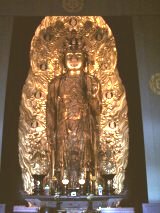  11-Headed Kannon of Hase Dera (in Kamakura) 11-Headed Kannon of Hase Dera (in Kamakura)
This large 11-headed gilt statue (see photo at right), reportedly built sometime in the 8th century, stands over nine meters high, making it the largest wooden statue of old Japan. Temple lore says this wooden statue was carved from a giant camphor tree by the monk Tokudo in 721 AD, who made two images from the same tree. The first image was enshrined in a temple in Nara Prefecture, while the second (the statue now at Hase Dera in Kamakura) was cast into the sea with prayers that it float to an area where it had greatest karmic connection and thereafter save souls in that area. According to legend, it washed up on shore in 736, at Nagai, in the Miura Peninsula, slightly south of Kamakura, glowing brightly, it is said, and later it was transferred to its present site at Hase Dera in Kamakura. <Source: Hase Dera in Kamakura>
|
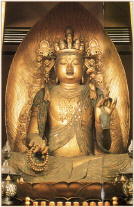
Juichimen Kannon
11-Headed Kannon (Wood)
10th to 12th Century
Rakuya-ji Temple 櫟野寺, Kyoto
|
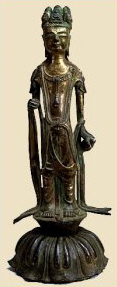
Juichimen Kannon
7th Century, Horuyu-ji Temple
Submitted by site visitor
|

Juichimen Kannon
(11-Headed Kannon)
Late 8th Century
Kaniman-ji Temple
|
|

Juichimen Kannon
11-Headed Kannon (Wood)
Late Heian Era
Onsen-ji Temple
|

Juichimen Kannon
11-Headed Kannon (Wood)
Edo Era
Hase Dera
|
|
|

Kanzeon 観世音 or Kanzejizai 觀世自在 or Kanjizai 観自在
Other Japanese names for Kannon are Kanzeon, Kanzejizai, or Kanjizai, the one who constantly surveys (kan 観) the world (ze 世) listening for the sounds (on 音) of suffering. These names were later shortened to Kannon. One of the 25 Bodhisattva who accompany Amida to lead the departed souls of the faithful into Amida’s pureland. Xuánzàng (602-664 AD), a noted translator of Sanskrit into Chinese, rendered Kannon's name as Kanjizai 觀自在 (unimpeded observer), while Kumārajīva 鳩摩羅什 (+344–413), another noted translator, rendered Kannon’s name as Kanzeon 觀世音 (the lord who responds to the sufferings of the world). See 11-Headed Kannon for more details.

Karamatsu Kannon 唐松観音
Karamatsu is the term for “Japanese Larch,” a species of deciduous coniferous trees native to Japan. On the 33-Site Pilgrimage to Kannon locations in Yamagata Prefecture, the fifth temple in the circuit (constructed around 1100 years ago) is devoted to Karamatsu Kannon and patterned after the platform style of the famous Kiyomizu Dera, a temple in Kyoto. Another location devoted to this deity is Karamatsu Jinja Shrine 唐松神社, one of the most famous Shinto shrines in Akita Prefecture, reportedly built over 1000 years ago. Says site contriburtor Gabi Greve: “The original priest of the shrine is said to be a descendant of a god. The beautiful rows of Karamatsu trees lining the path to Karamatsu Shrine are over 300 years old and are said to have been planted by the Satake feudal clan in 1680. In the Edo Period, Princess Hisashi of the Satake feudal clan suffered during child birth, and it is recorded that she visited Karamatsu Shrine. ’I heard that the god of childbirth resides at Karamatsu Shrine in Senboku. I prayed for safe childbirth and for this god to alleviate my pain,’ said the Princess. At the exact moment the servants prayed for a safe childbirth, the princess safely delivered a baby boy. The Satake feudal lord gave Karamatsu Shrine a wooden snake mask in gratitude for the safe delivery of the child, and it is said that at this moment the snake whirled around – a sign that the god was pleased. The mask is still displayed today, and has been designated a ‘Prefectural Important Cultural Asset.’ Karamatsu Shrine is still a site of pilgrimage and women come from all over Japan to pray for safe delivery. <Sources: Gabi Greve and Daisen City, Akita 秋田県大仙市>

Kebutsu 化仏
 A smaller image attached to a larger image. Found often with Kannon statuary, especially when Kannon is represented as one of the two main attendants of Amida Buddha in Amida Sanzon Artwork 阿弥陀三尊 (Amida Triad). In such artwork, a small image of Amida is often placed atop Kannon’s crown -- for Kannon is considered an active emanation (one who represents compassion) of Amida. The other attendant, Seishi Bosatsu, represents wisdom and is often depicted with a crown containing a small water bottle (suibyō 水瓶). A kebutsu of Amida is also found frequently inside the crown of statues of the 1000-Armed Kannon and the 11-Headed Kannon. A smaller image attached to a larger image. Found often with Kannon statuary, especially when Kannon is represented as one of the two main attendants of Amida Buddha in Amida Sanzon Artwork 阿弥陀三尊 (Amida Triad). In such artwork, a small image of Amida is often placed atop Kannon’s crown -- for Kannon is considered an active emanation (one who represents compassion) of Amida. The other attendant, Seishi Bosatsu, represents wisdom and is often depicted with a crown containing a small water bottle (suibyō 水瓶). A kebutsu of Amida is also found frequently inside the crown of statues of the 1000-Armed Kannon and the 11-Headed Kannon.
Says JAANUS: Also Ōkebutsu 応化仏, Hengebutsu 変化仏, Ōshin 応身, or Keshin 化身. Skt. = Nirmana Buddha. Lit. Transformed Buddha = 化仏 A small Buddhist image attached to a larger image which is a manifestation of a Nyorai 如来 (Buddha) that has transformed into another body and is represented along with an associated Buddha or Bodhisattva. Buddhist deities can assume many forms in order to save sentient beings and the kebutsu is an example of this benevolent transformation. The term kebutsu appears to have been used in sutra commentaries, for example the BISHAMONRON 毘沙門論, as early as the beginning of the 11c. The best-known example is probably the small figure of Amida on the front of the crown of many Kannon statues. The seven small Buddha images on the halo (kouhai 光背) of the Yakushi Buddha 薬師 at Shin'yakushiji 新薬師寺, and the numerous Buddha figures on the halo of Rushanabutsu Buddha 盧遮那仏 at Toushoudaiji Temple 唐招提寺, are also well-known examples of the kebutsu. One of the attributes held in the hands of the Thousand-Armed Kannon is a small image of Amida, considered to be a kebutsu. The small Buddha images that are depicted coming out of the mouth of famous Buddhist leaders, such as Kūya Shūnin 空也上人 (+903-972) or Kuuya Shuunin, at Rokuharamitsuji Temple 六波羅密寺 Kyoto (early 13c), are kebutsu which serve to represent the syllables of the nenbutsu 念仏 or the recitation of Amida's name. The term kebutsu is also applied to the small heads displaying various emotional states that are arranged on top of the main head of the 11-Headed Kannon.” <end JAANUS quote>

Koyasu Kannon 子安観音
 Lit. = Safe Childbirth Kannon. Bestower of Children. Goddess who grants children, safe delivery, and help in rearing children. Statues of this goddess often (but not always) depict her nursing a baby. This child-giving form of Kannon incorporates the functions of Koyasu-sama, the Shintō goddess of easy childbirth, and was reportedly developed late in popular Buddhism to supplant the Shintō deity. Nonetheless, Shintō shrines dedicated to Koyasu-sama still exist in modern times. These shrines are known as Asama Shrines 浅間神社 (also pronounced Sengen). More than 1,000 Asama (Sengen) shrines exist across Japan, with the head shrines standing at the foot and the summit of Mount Fuji itself. These sanctuaries are dedicated to Koyasu’s namesake, the mythical princess Konohana Sakuya Hime 木花之佐久夜毘売, the Shintō deity of Mount Fuji, of cherry trees in bloom, and the patron of safe delivery. In Shintō mythology, Konohana (lit = tree flower) is the daughter of Ōyamatsumi (the earthly kami of mountains). She was married to Ninigi 邇邇芸尊 (heavenly grandchild of sun goddess Amaterasu), became pregnant in a single night, and gave birth to three children while her home was engulfed in fire -- thus her role as the kami who grants safe childbirth. In some accounts she died in the fire, and thus she is likened to the short-lived beauty of the cherry blossom. <Source: Konohana Sakuya Hime and Koyasu-sama; both from the Kokugakuin University Shintō Encyclopedia > Lit. = Safe Childbirth Kannon. Bestower of Children. Goddess who grants children, safe delivery, and help in rearing children. Statues of this goddess often (but not always) depict her nursing a baby. This child-giving form of Kannon incorporates the functions of Koyasu-sama, the Shintō goddess of easy childbirth, and was reportedly developed late in popular Buddhism to supplant the Shintō deity. Nonetheless, Shintō shrines dedicated to Koyasu-sama still exist in modern times. These shrines are known as Asama Shrines 浅間神社 (also pronounced Sengen). More than 1,000 Asama (Sengen) shrines exist across Japan, with the head shrines standing at the foot and the summit of Mount Fuji itself. These sanctuaries are dedicated to Koyasu’s namesake, the mythical princess Konohana Sakuya Hime 木花之佐久夜毘売, the Shintō deity of Mount Fuji, of cherry trees in bloom, and the patron of safe delivery. In Shintō mythology, Konohana (lit = tree flower) is the daughter of Ōyamatsumi (the earthly kami of mountains). She was married to Ninigi 邇邇芸尊 (heavenly grandchild of sun goddess Amaterasu), became pregnant in a single night, and gave birth to three children while her home was engulfed in fire -- thus her role as the kami who grants safe childbirth. In some accounts she died in the fire, and thus she is likened to the short-lived beauty of the cherry blossom. <Source: Konohana Sakuya Hime and Koyasu-sama; both from the Kokugakuin University Shintō Encyclopedia >
Scholar Lucy S. Itō, in an article entitled “Japanese Confraternities, Kō” appearing in Monumenta Japonica, VIII, 1952, pp.412 & 414) says that Koyasu-sama was venerated mostly in Japan’s Kantō area (around Tokyo and Chiba), where women would offer rice to the deity while asking for healthy milk after childbirth. Itō’s article describes associations of women known at “Koyasu-kō” that have sprung up to pray to Koyasu Kannon and Koyasu Myōjin (the Shintō counterpart) to cure infertility.
Despite the survival of Shintō’s Koyasu-sama into modern times, she has been largely supplanted by her Buddhist equivalents, known as Koyasu Kannon (page you are now viewing), Jibo Kannon (loving mother), Koyasu Jizō, and Koyasu Kishibojin. Also see Patrons of Motherhood & Children for more deities.
According to Buddhism: Flammarion Iconographic Guides by Louis Frederic: “Tradition relates that a statue of Koyasu Kannon was made in the eighth century in the image of the Empress Kōmyō 光明 (or Komei, 701-760), widow of Emperor Shōmu 聖武 (reigned 724-749) and mother of Empress Kōken 孝謙天皇 (reigned 749-758). Empress Kōken became a nun in 749. Undoubtedly, this feminine aspect of Avalokitesvara (Kannon), the symbol of abnegation and love, contributed greatly to the spread of her cult in Japan. However, it was only from the fourteenth century, perhaps under the influence of the Nichiren sect, that people worshipped Koyasu Kannon as ’giver of children.’ Some statues of Ksitigarbha (Jizō Bosatsu) are worshipped in the same way in Japan. They differ in no way from the normal images representing this deity, except that this form is named Koyasu Jizō, due to the powers attributed to her.” <end quote Buddhism: Flammarion Iconographic Guides by Louis Frederic, printed France, ISBN 2-08013-558-9, 1st Published 1995, Pages 178-180>
Even today, the Koyasu-no-tō Pagoda 子安の塔, a three-tiered Edo-period structure inside the compound of famed Kiyomizudera Temple 清水寺 in Kyoto, remains a popular site for those praying for easy childbirth. Statues of Koyasu Kannon from the Edo period onward are sometimes decked in red by couples praying for a child. Statues also often depict Koyasu Kannon nursing a baby, but such artwork is not generally considered of Buddhist origin. Instead, such images apparently emerged during the Tokugawa Era 徳川時代 (+1615-1867), more commonly known as the Edo Period 江戸時代, when Japanese converts to Christianity were persecuted and Christianity itself banned. To hide their faith, Christians openly worshipped Buddhist images of Koyasu Kannon or Jibo Kannon, but these images were ingeniously disguised to look like the Virgin Mary (see Maria Kannon for details), and often contained a hidden cross inside the body of the statue.
In related matters, some of the most common feminized forms of Kannon in Japan are Koyasu Kannon (easy delivery), Jibo Kannon (loving mother), Mizuko Kannon (savior of aborted children), and Gyoran Kannon (carrying fish basket). Kannon’s Śakti is Tara Bosatsu, who is sometimes depicted as Kannon’s wife; Śakti is Sankrit for “female personification or avatar of the male.” Kannon is also often paired with the Shintō Sun Goddess Amaterasu in Japan’s Kami-Buddha matrix.

  Kudara Kannon 百済観音 Kudara Kannon 百済観音
Kudara Kannon
7th Century
百済観音
  
Houryuuji Temple 法隆寺 (Nara)
Wood (Gilded Camphor 樟)
with Polychromy
H = 210 cm
Most scholars believe this statue came from Korea or was made by Korean artisans living in Japan. The name of the statue -- Kudara Kannon 百済観音 -- literally means "Paekche Kannon." Paekche (Paekje 百済) was one of three kingdoms in Korea during this period, and Kannon is one of the most beloved Buddhist deities in Asia. The statue’s extreme thinness seems at first bizarre, but the serenity in the face and the beautiful openwork bronze in the crown are marvelous. The vase symbolizes the “nectar” of Kannon’s compassion -- it pacifies the thirst of those who pray to Kannon for assistance.
There are many indications that the statue came from Korea (or was made by Korean artisans in Japan). The superior workmanship of the piece, plus many of the stylistic nuances (faint smile, slender face, thin body, folds in garment, halo) are all hallmarks of Paekche artisans and generally conform to artwork from Korea’s Three Kingdom Period. In the book Korean Impact On Japanese Culture (Korea: Hollym International Corp., 1984), authors Jon Carter Covell and Alan Covell say the foremost clue of Paekche influence is the crown's honeysuckle-lotus pattern, which can also be found among the artifacts discovered in the tomb of Paekche's King Munyong (reigned +501-523). The coiling of the vines, they say, plus the number of protrusions from the crown petals, are nearly identical to similar extant Korean pieces.

Kumen Kannon 九面観音
A form with nine heads, much less common than the 11-Headed version. Example: 8th century Danzō 檀像 at Hōryūji Temple 法隆寺 in Nara. See photo here.

Kuse Kannon, Kuze Kannon.
An alternative spelling of Guze Kannon.

|
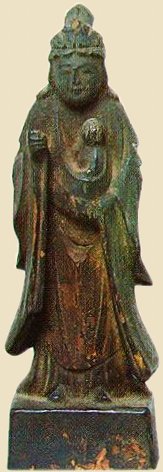
Maria Kannon
Edo-period (circa 1714).
Found hidden inside an Amida Statue. Treasure of Kawaguchi City, Saitama Prefecture. Source: This J-Site.
|
|
 Maria Kannon マリア観音 Maria Kannon マリア観音
Statues of the Virgin Mary (Mother of Christ) disguised as Kannon (Goddess of Mercy). Christianity in Japan was banned for over two centuries during the Tokugawa (aka Edo) Era 徳川時代 (+1615-1867). In the mid-17th century, the hidden Christians (kakure kirishitan 隠れキリシタン) in the Nagasaki area and elsewhere created statues of the Virgin Mary disguised as the Buddhist deity Kannon. These images, called Maria Kannon, were made or altered to look like Kannon, but they were not worshipped as Kannon. Instead, the Christians venerated these Buddhist statues by silently praying to Mother Mary. Many statues, moreover, had a Christian icon hidden inside the body or camouflaged in the artwork. During the dark years of anti-Christian persecution in Japan, these secretive methods fooled government agents and helped the Christians to keep their faith hidden and alive. For more details and photos, see the Maria Kannon sidepage.
Maria Kannon statues were commonly made of white or blue porcelain. Many were effigies of Koyasu Kannon (propitated for easy childbirth) that resembled the popular White-Robed Kannon in appearance but holding a child, or of Jibo Kannon (Loving Mother Kannon) holding a child. This imagery could easily double for secret veneration of the Virgin and Child.
Less common Japanese images of the Kannon showed her nursing a baby. This latter form apparently appeared in the anti-Christian Edo era and is not generally considered of Buddhist origin.
Quotes from various resources:
- "In Amakusa peasants hid their Christianity from government agents by employing extraordinary tactics. They worshipped Christianity by making the articles of the Christian faith look like the articles of Buddhism. For example, figurines of the Buddhist goddess Kannon were altered so that they could double as Mother Mary. They hid crosses behind statues of the Buddha so as to worship the cross behind the Buddha." <quote from Ariake Town, Kumamoto Pref.>
- “The camouflaged Virgin Mary -- in the disguise of the bodhisattva Kannon -- provided the Kakure Kirishitan with a sacred image upon which to focus their worship and ritual under very difficult circumstances. The concealed sign of the cross -- placed somewhere on the image (often on the back of the statue) -- is usually the only feature that distinguishes it from a typical Buddhist image. Kentaro Miyazaki 宮崎賢太郎, one of the foremost authorities on the Kakure Kirishitan, explains that: ‘The Maria Kannon is often a figure of Koyasu Kannon or Jibo Kannon [which portrayed a mother holding a child] in white or blue porcelain, imported from China. In times of persecution during the Edo period, the underground Kirishitan could not possess a figure of the Christian Virgin Mary, therefore they projected Mary's image on the gentle image of the Buddhist Kannon and venerated her in this way.’” <excerpt Mark R. Mullins, The Many Forms and Functions of Kannon in Japanese Religion and Culture>
- GOOGLE IMAGES. Click Here.

  Miraculous Japanese Legends About Kannon Miraculous Japanese Legends About Kannon
Miracle stories about Kannon, imported originally from Tang China, were particularly widespread in old Japan, and remain so even today. One of Japan's oldest extant setsuwa 説話 collections (i.e., tales of strange and bizarre events, explained largely in terms of karma, transmigration, and other Buddhist beliefs) is known as the Nihon Ryōiki (Nihon Ryoki) 日本霊異記. Compiled in the early ninth century by the Japanese monk Kyōkai 景戒 (also pronounced Keikai), the full title of this three-volume work is 日本国現報善悪霊異記 (Nihonkoku Genpō Zen'aku Ryōiki or “Miraculous Stories of Karmic Retribution of Good and Evil in Japan”). A marvelous English translation, which includes copious annotations, was done by Kyoko Motomochi Nakamura in 1973 and is entitled "Miraculous Stories from the Japanese Buddhist Tradition." It is available and highly recommended (Harvard University Press, ISBN 0-7007-0449-3, 322 pages). Below are some abridged passages from her book:
- "Among the Buddha and Bodhisattva found in the Nihon Ryōiki, Kannon is the most popular and remains a center for devotion by all classes of people. There are 17 stories on Kannon, six on Miroku, three each on Amida, Shakyamuni, and Myōken, and two each on Kichijōten and Yakushi (p. 85)."
- "Ganjin, a famous blind preceptor who came from China to establish the ordination platform at Emperor Shōmu's invitation, was a great devotee of the Thousand-Armed Kannon, probably because that Kannon was believed to cure blindness (p. 87)."
- "In boundless compassion, Kannon is eternally at work to protect and save all sentient beings in this world and an infinite number of other worlds. One tradition explains how the Eleven-Headed Kannon came into being by a story: Avalokitêśvara once looked down on the suffering of the world and was so distressed by the sight that his head split into eleven pieces (p. 87)."
- "In medieval China, many legends about a girl who is identified as an incarnation of the Thousand-Armed Kuan-yin illustrate the process of acceptance of Kuan-yin as a young woman. Obviously Tantric Kuan-yins preceded beautiful female Kuan-yins in China. In the Nihon Ryōiki, three stories are on the Eleven-Headed Kannon and Thousand-Armed Kannon, while one is on the Kannon based on the Lotus Sutra (p. 87)."
- "The author Kyōkai was moved to compile these stories both by a sense of awe of the Buddhist dharma (teachings) and by a sense of the wonder of the world. He lived a monastic life at a temple called Yakushi-ji 薬師寺, one of the great state temples in Nara, during a period of political change when the capital was in the process of being moved from Nara to Nagaoka and then to Kyoto. His work served as a source from which his fellow monks might draw 'true stories' to illustrate their popular preaching. It has also become the source of later legendary literature in Japan, many of its motifs reappearing in more elaborate and polished forms. It is quoted by historians and folklorists in their attempts to reconstruct the history and popular Buddhism of the Nara period. (p. vi)."
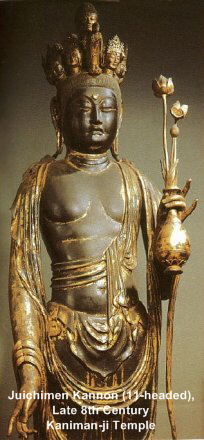  OTHER KANNON LEGENDS OTHER KANNON LEGENDS
- Minamoto Yoritomo, the founder of the Kamakura Shogunate, always carried a small statue of Kannon under his helmet (inserted in his hair topknot) during battle. <need to give source>
- An amulet containing the Lotus Sutra (the key scripture in Japan underpinning Kannon belief) deflected an arrow and thus saved the life of Kusunoki Masahige, the most celebrated samurai of the early 14th century. <need to give source>
- Chinese Legends About Kannon. Known as Guanyin (Kuan-yin) in China, the Kannon is said to be the spiritual son of Amitabha (Amida), although images of the Kannon appear mostly as a goddess. The Chinese also say that Kuan-yin (Kwanjin) was born into this world as the daughter of the King of the Chow Dynasty. Sentenced to death by her father for refusing to marry, she was sent to the executioner’s block, where it is said the executioner’s sword broke without inflicting a wound. Other Chinese tales say her spirit was once transported to the underworld, where King Yama (Skt.), the lord of hell, attended to her with great respect. But her radiance turned hell into paradise, so King Yama sent her back to earth again, transporting her on a lotus flower. <need to give source>
- There are many other famous legends. In the Legend of Miaoshan (text by Chinese Buddhist monk Puming, written after a vision he experienced in 1103 AD), the king’s daughter gives up her own eyes and arms to help cure her ailing father. In another legend, said to have occured in 817 AD during the Chinese Tang dynasty, a beautiful girl in the countryside was much sought after for marriage by eligible young men. As the number of men who were eager to marry her was large, she adopted a novel method for selecting a suitor. She put forth a condition that she would marry the person who would memorize the Guanyin chapter of the Lotus Sutra in one night. Twenty men succeeded in doing this but because there were still too many for the marriage, she again made a request that these twenty should learn by heart the Vajracchedika sutra overnight. Once again there was a sizable number of men who had achieved the feat. The girl's third condition was that he who memorized the entire Lotus Sutra in just three days could marry her. A man named Ma Lang was the only one who could accomplish this and so the marriage was to take place. Just as the marriage ceremony was to commence the girl took ill and died. Soon after the burial an old priest visited Ma Lang and requested him to dig up the grave. The coffin contained only pieces of golden bones. The old priest said that the girl was a manifestation of Guanyin who had come to lead people to salvation. After saying this the old man too vanished. From then on the people of the district became Guanyin devotees. <For much more on Kannon lore, please see THE CREATION OF GODDESS OF MERCY FROM AVALOKITESVARA, from the Indira Gandhi National Centre for the Arts (New Delhi). The story of Ma Lang, quoted above, comes from this site.>
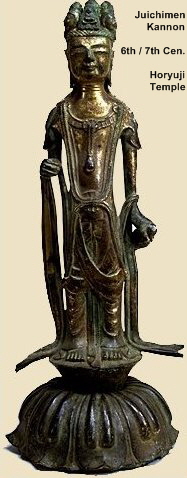  In India, said to be the daughter of King Śubhavyūha 妙莊王, who had her killed by "stifling” because the sword of the executioner broke without hurting her. Her spirit went to hell; but hell changed into paradise. Lord Yama (Skt.) sent her back to life to save his hell, when she was miraculously transported on a Lotus flower to the island of Pu-To." (Eitel; Muller; Soothill] In India, said to be the daughter of King Śubhavyūha 妙莊王, who had her killed by "stifling” because the sword of the executioner broke without hurting her. Her spirit went to hell; but hell changed into paradise. Lord Yama (Skt.) sent her back to life to save his hell, when she was miraculously transported on a Lotus flower to the island of Pu-To." (Eitel; Muller; Soothill]
- Kannon Reigenki 観音霊験記. Famous Ukiyoe 浮世絵 (woodblock) artist Utagawa Kunisada 歌川国貞 (1786-1864) published a series of Kannon paintings known in English as the “Mysterious Stories of Kannon Bodhisattva.” Click here for numerous photos.
- JAANUS www.aisf.or.jp/~jaanus/deta/k/kannon.htm
Since around the 14th century, illustrations of the stories of Kannon temples and images were produced in abundance. Images of Kannon were made as part of Emperor Shōmu's 聖武 (reigned 724 to 749) effort to impose Buddhist structure on Japan. Temples dedicated to Kannon were founded, many following the apparition of the deity or the miraculous appearance of an image. A temple dedicated to Kannon was often built in a mountain, beside a rock formation, near a spring, or near some other remarkable landscape feature, suggesting that the site was already sacred and was adapted to Buddhist use. Stories of such images and temples abound among engi 縁起 (origin stories) and setsuwa 説話 (religious stories), and they found expression in accompanying paintings (shaji engi-e 社寺縁起絵).
- JAANUS www.aisf.or.jp/~jaanus/deta/s/shajiengie.htm
Shaji Engi-e 社寺縁起絵. Often abbreviated as Engi-e 縁起絵. Paintings of the origins and history of a temple or shrine, usually amplified with legends accompanied by miraculous stories (REIGEN SETSUWA 霊験説話 = lit."explanations and stories of beneficial effects of spirits"), added in order to propagate the institution or sect's teachings and to enhance its prestige. Pictorializations tended to require many scenes and so were executed either on handscrolls (Emaki 絵巻), in compositions of ten in horizontal registers, or incorporating many scenes on hanging scrolls (kakemono 掛物).

Mizuko Kuyō Kannon 水子供養観音
|
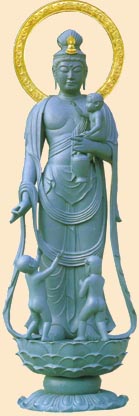
Mizuko Kuyō Kannon
Daikannon-ji Temple
Mie Prefecture
Photo this J-site
|
|
Patron of departed souls, especially children lost to miscarriage, stillbirth, or abortion. A modern form of Kannon. This role is also played in contemporary Japan by Mizuko Jizō Bosatsu. There are antecedents to this role, in particular the Legend of Sai no Kawara 賽の河原, which is attributed to Japan’s Jōdo Pure Land sects from around the 14th or 15th century AD. According to this legend, children who die prematurely are sent to Sai no Kawara, the riverbed of souls in purgatory. They may be pure souls, but they have not had any chance to build up good karma, and their untimely death caused great sorrow to their parents, and thus, they too, must undergo judgment by the 10 Kings of Hell. Says scholar Mark R. Mullins in The Many Forms and Functions of Kannon in Japanese Religion and Culture:
“I would like to draw attention to both continuity and change in the functions and forms of Kannon in contemporary Japan. One of the most prominent developments has been in relation to mizuko kuyō 水子供養 (mizuko kuyo), which refers to memorial services for children lost through miscarriage, stillbirth, and abortion. This is a topic that has been the focus of considerable research in recent decades.[footnote 1] Mizuko clearly fall into the category of those who have died an untimely or "bad" death and reside in a nearby spirit world along with other muen-botoke 無縁仏 (people who died with no one to look after their graves), or gaki (hungry ghosts). According to popular beliefs, such spirits hover around the living with a feeling of urami 恨み (resentment) and are the potential source of tatari たたり (retribution, curse). While the Bodhisattva Jizō, a popular savior figure devoted to children, has been the dominant figure in mizuko rites, in recent years Kannon has also been given a prominent place in a number of temples devoted to this practice. Given the long history of identification of Kannon with the needs of mothers and children, it is not surprising that Kannon has also been appropriated as a central figure in these memorial rites -- both to care for spirits in the ’other world’ and to comfort those in the world of the living who oftentimes are struggling with personal remorse, regret, and guilt. Kannon and Jizō are clearly both highly adaptable savior figures who are able to appear in diverse settings to address a variety of needs.
Today there are numerous temples that have appropriated Kannon as a central figure in mizuko kuyō rites throughout Japan. Newspapers carry advertisements for these rites, and in recent years some temples maintain Internet sites to promote these services. The homepage of Daikannon-ji Temple 大観音寺 in Mie Prefecture, for example, claims that its three Kannon images (Mizuko San Kannon) are the best in the land and explains the specific functions and benefits of each Kannon as follows: The Jibo Mizuko Kannon 慈母水子観音 takes the place of the parents and provides for the mizuko in the other world with a heart of compassionate love; the role of the Shō Mizuko Kannon 聖水子観音 is to remove the evil spirit that has attached itself to the mizuko and provide protection; finally, the Daihi Mizuko Kannon 大悲水子観音 is able to save all mizuko -- without exception -- and transport them to paradise.[footnote 2] Another example is the Reizan Kannon 霊山観音 at Akasaka Betsuin 赤坂別院 (in Akasaka, Tokyo), a small Buddhist temple also devoted exclusively to mizuko kuyō.[footnote 3] It provides similar services but at a more reasonable rate.” <end quote by Mark R. Mullins>
- SOURCE: Mark R. Mullins, The Many Forms and Functions of Kannon in Japanese Religion and Culture. Published in the April-June 2008 issue of Dharma World. Mullins is a member of the Faculty of Liberal Arts and Graduate School of Global Studies at Sophia University, Tokyo, where his teaching and research focuses on religion in modern society.
- Footnote 1. The literature on mizuko kuyo is already quite extensive. Some representative works in English include Ann Page Brooks, "Mizuko Kuyo and Japanese Buddhism," Japanese Journal of Religious Studies 8, no. 34 (1981); Eiki Hoshino and Dosho Takeda, "Mizuko Kuyo and Abortion in Contemporary Japan," in Religion and Society in Modern Japan: Selected Readings, ed. Mark R. Mullins, Susumu Shimazono, and Paul Swanson (Berkeley, CA: Asian Humanities Press, 1993); and Helen Hardacre, Marketing the Menacing Fetus in Japan (Berkeley: University of California Press, 1997).
- Footnote 2. The cost for kuyo services is thirty-five thousand yen (US$330) for one mizuko, and sixty-five thousand yen (US$600) for two. All of the transactions can be conducted by sending funds to the temple's bank or postal account. This information has been gleaned from Daikannonji's home page; see daikannon.or.jp/mizuko/top.html.
- Footnote 3. See mizuko-kuyo-akasaka.org for more info on this specialized temple.

Nyoirin Kannon 如意輪観音
 One of many esoteric forms of Kannon in Japan and one of Six Kannon who preside over the six realms of karmic rebirth. In statuary, the six-armed version (one for each karmic realm) is the most prevalent, although there are two, four, eight, and 12-armed versions as well. Images of Nyoirin began appearing in Japan during the Heian period (794-1185 AD). Japan’s oldest extant Nyoirin statue is dated to approx. 840 AD and installed at Kanshinji Temple 観心寺 in Osaka (see photo below). The defining attributes of Nyoirin are the wish-granting jewel (nyoi hōju 如意宝珠) and the eight-spoked Dharma wheel (rinpō 輪宝), which s/he is always holding. The wheel symbolizes the teachings of Buddhism and the eight-fold path. The deity’s name is thus commonly translated as “Bodhisattva of the Jewel and the Wheel.” A less-common translation is “Omnipotent Kannon.” Most often shown sitting on a lotus or atop a rock that rises from the sea (indicating Kannon’s holy land Fudarakusen), Nyoirin appears in numerous esoteric texts, including the Hodaraku Kaie Ki 補陀落海會軌 [T 1067.20.131a27], translated into Chinese by Amoghavajra (705–774), and the Dainichi-kyō-sho-en-ō-shō 大日經疏演奧鈔 [T 2216.59.0174b29 - 0175b15], translated by Tōji scholar-monk Gōhō 杲宝 (1306-1362). One of many esoteric forms of Kannon in Japan and one of Six Kannon who preside over the six realms of karmic rebirth. In statuary, the six-armed version (one for each karmic realm) is the most prevalent, although there are two, four, eight, and 12-armed versions as well. Images of Nyoirin began appearing in Japan during the Heian period (794-1185 AD). Japan’s oldest extant Nyoirin statue is dated to approx. 840 AD and installed at Kanshinji Temple 観心寺 in Osaka (see photo below). The defining attributes of Nyoirin are the wish-granting jewel (nyoi hōju 如意宝珠) and the eight-spoked Dharma wheel (rinpō 輪宝), which s/he is always holding. The wheel symbolizes the teachings of Buddhism and the eight-fold path. The deity’s name is thus commonly translated as “Bodhisattva of the Jewel and the Wheel.” A less-common translation is “Omnipotent Kannon.” Most often shown sitting on a lotus or atop a rock that rises from the sea (indicating Kannon’s holy land Fudarakusen), Nyoirin appears in numerous esoteric texts, including the Hodaraku Kaie Ki 補陀落海會軌 [T 1067.20.131a27], translated into Chinese by Amoghavajra (705–774), and the Dainichi-kyō-sho-en-ō-shō 大日經疏演奧鈔 [T 2216.59.0174b29 - 0175b15], translated by Tōji scholar-monk Gōhō 杲宝 (1306-1362).
According to Matsunami Kōdō 松濤弘道 (born 1933), a Buddhist scholar and one-time chairperson of the Japan Buddhist Federation: "Each of the six arms represents a vow to save beings in one of the six realms of rebirth."
- right hand touching cheek represents vow
to save beings in hell
- right hand holding a wish-fulfilling jewel represents
vow to save those in the realm of hungry ghosts
- right hand holding a rosary represents vow
to save those in the animal realm
- left hand touching lotus throne represents vow to save those in realm of demons called Asura
- left hand holding lotus bud represents vow
to save those in the human realm
- left hand holding Dharma wheel represents vow to save those in the heavenly Deva realm
Above list adapted from "Essentials of Buddhist Images: A Comprehensive Guide to Sculpture, Painting, and Symbolism" by Matsunami Kōdō; first English edition March 2005; published by Omega-Com.
Says the Digital Dictionary of Buddhism: “One of the six forms of Avalokitêśvara. Saves all beings with the gem of satisfaction 如意珠 and the wheel of the law 法輪. Transliterated as 震多摩尼斫迦羅.” <end quote>. Says JAANUS: Nyoirin was worshipped as a deity who protected the life of the emperor. The well-known 9th-century wooden statue at Kanshinji 観心寺 (Osaka), as well as Nyoirin images at Murōji 室生寺 (Nara) and Kannōji 神呪寺 (Hyōgo Prefecture), make a group of three masterpieces called San Nyoirin 三如意輪.” <end quote> See photos of the Three Nyoirin below.
|
Three Nyoirin Masterpieces known as the San Nyoirin 三如意輪
|
|
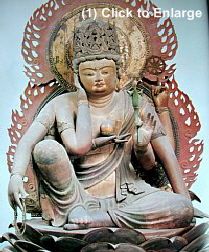
|
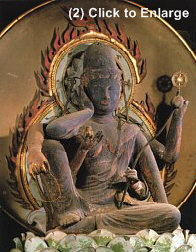
|
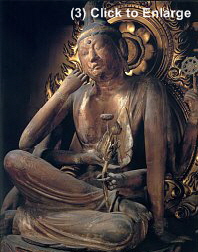
|
|
PHOTO CAPTIONS
- Six-Armed Nyoirin. Oldest statue of Nyoirin Kannon in Japan. Painted Wood, H = 108.8 cm, Mid-9th Century, Kanshinji Temple 観心寺 (Osaka). Designated National Treasure. Photo from Keio University.
- Six-Armed Nyoirin. Painted Wood, H = 78.7 cm, Heian Era, ICP. Murōji Temple 室生寺 (Nara). Photo this J-site.
- Six-Armed Nyoirin. Painted Wood, Yosegi-zukuri (joined block), H = 98.7 cm. Kannōji Temple 神呪寺 (Hyōgo), Heian Era, ICP. Photo: 日本の秘仏, The Hidden Buddha of Japan, 2002, Corona Books, ISBN 4-582-63395-1
|
|
The six-armed Nyoirin Kannon appears often in the Taizōkai (Matrix) Mandala, wherein the deity is is often colored in gold. Nyoirin is also the central deity in the Nyoirin Kannon Mandala, as well as the object of veneration in rituals to the seven stars of the Big Dipper. The Seven-Star Nyoirin Kannon ritual was conducted from the late Heian period onward to increase one’s lifespan. Various ritual artwork is still extant (e.g. Kanazawa Bunko Museum 金沢文庫), and the ritual itself is described in an extant 13th-century text known as Shichisei Nyoirin Danyō 七星如意輪壇様.
Nyoirin underwent a gender change after arriving in Japan. Originally male in the esoteric pantheon of mainland Asia, the deity in Japan was identified with several feminine deities and ultimately considered female. Says scholar Sarah Fremerman in a presentation given at the annual meeting (March 4-7, 2004) of the Association for Asian Studies:
“Beginning in the Nara period, faithful attempts to transmit Chinese esoteric Buddhist lineages to Japan gave rise to a whole new body of esoteric teachings (mikkyō). One striking example of this phenomenon is the cult of Nyoirin Kannon, a Tantric manifestation of Avalokitesvara depicted holding a wish-fulfilling jewel (cintamani) and a ’wheel of dharma.’ In Japan, Nyoirin gained a widespread popularity that her cult had never claimed in China -- she now served as a guardian of esoteric power associated with the cintamani and thus also identified with relics, as well as a beloved granter of worldly benefits. As the bodhisattva became identified with several feminine deities in Japan, particularly the ‘jewel woman’ (J. gyokujo), her gender changed from male to female and she became a favorite object of devotion for women. Yet Nyoirin iconography retained a distinctly Central Asian flavor, particularly her posture of ’royal ease’ often found in paintings at Dunhuang and other sites, but less common in Japan. One rich source of information on Nyoirin’s cult in both China and Japan is Bodhiruci’s translation of the Dharani Sutra of Cintamanicakra (Ruilun tuoluoni jing), which gives a description of the bodhisattva and the esoteric ritual centered on the recitation of her dharani, identified as the cintamani. Japanese sculptures and paintings of Nyoirin, and comparison with their Chinese predecessors, provide further clues for understanding how the cult of Nyoirin Kannon developed in Japan.” <end quote from the Association for Asian Studies>. See Nyoirin Resources below for more from Sarah Fremerman. Her 2008 Ph. D dissertation for Stanford University was entitled “Divine Impersonations: Nyoirin Kannon in Medieval Japan.”
Images of Nyoirin Kannon in Japan are also found frequently in graveyards. In the Edo Period (1615-1868), women-only confraternities (kō 講) of worship devoted to a female version of the wish-granting Nyoirin Kannon began to flourish. Called the Jūkūyakō 十九夜講 (lit. = 19th Night Club), such women-only clubs would gather each month on the 19th night of the lunar calendar to pray for fertility, easy delivery, healthy children, safety from women's diseases, and the repose of female friends and relatives who had passed on (hence the ubiquitous Nyoirin gravestone). In the Tsukuba 筑波 area of Ibaraki Prefecture 茨城県, for example, women even today gather on the 19th night of the lunar calendar, but now only twice yearly (not monthly as in the past). See this E-site for a modern review of the practice.
|
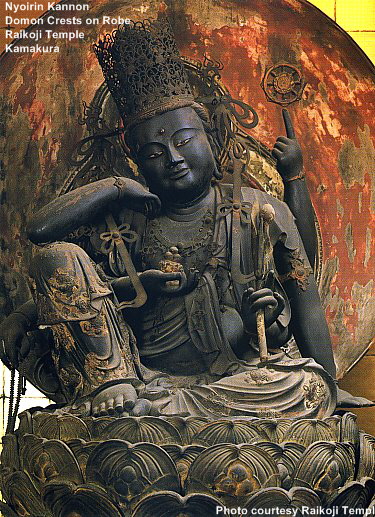
|
The Nyoirin Kannon 如意輪観音 statue at Raikōji (Raikoji) Temple 来迎寺 in Kamakura features beautiful "domon" 土紋, or clay crests. The domon technique was used for decorating Buddhist statues and is unique to the Kamakura period (1185-1332), and is thus also known as Kamakura Domon 鎌倉土紋. Clay is kneaded 練 (neru) into patterns or placed in molds and then affixed to the statue with lacquer, resembling a relief. The crests on the Raikoji statue are said to ward off evil (厄除け yakuyoke) and to ensure easy delivery (安産 anzan) to women in labor. Statue dated to 14th century.
Nyoirin Kannon Legend at Raikoji Temple: A sad story about the Nyoirin Kannon tells about a man in Yui 由比 (China), who was living a luxurious life, with not a care in the world. The man had a daughter he loved very much, but one day a large eagle swooped down and carried her off. The father frantically searched for his daughter, and although he eventually found her, she was dead. He interred her remains inside the body of this Nyoirin Kannon for the repose of her soul. <legend quoted from the Kamakura Citizens Net, as told by the temple>
|
|
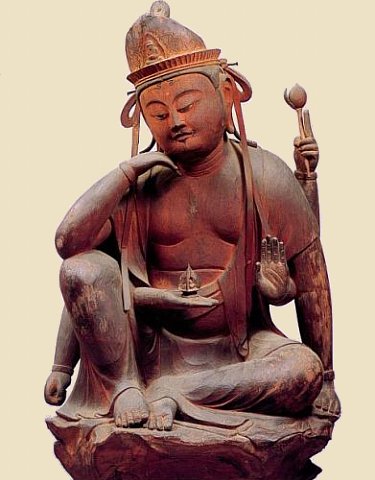
|
|
Nyoirin Kanzeon
如意輪観世音菩薩坐像
Heian Era, Height = 58.6cm
Designated National Treasure
Daimon-ji Temple 大門寺
Ibaraki City, Osaka
Photo this J-site
Shown sitting atop Kannon’s Fudaraku paradise
大門寺 如意輪観音坐像。大門寺のご本尊で、重要美術品にも指定されています。通常、蓮華座にお座りですが、この像は岩に坐している珍しい観音像です。この岩は観音菩薩の住処である補陀落山(ふだらくさん)を表しています。
|
|
|
|
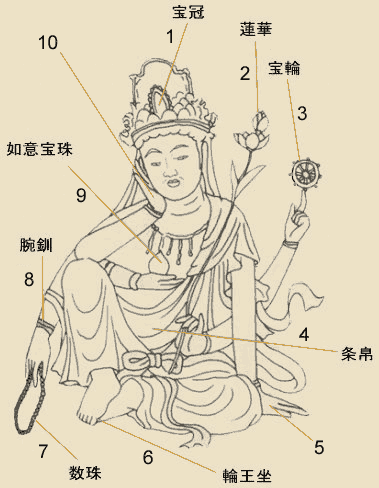
|
|
Nyoirin’s Main Attributes
- Hōkan 宝冠 = A crown, usually made in wood or bronze openwork.
- Renge 蓮華 = Lotus Bud, Lotus Petal. This left hand represents vow to save those in the human realm.
- Rinpō 輪宝 or Hōrin 宝輪 = Wheel of Dharma (Buddhist law), or Wheel of Royalty (Skt. = Cakra), usually eight-spoked to represent the eight-fold path to enlightenment. This left hand represents vow to save those in the heavenly Deva realm.
- Jōhaku 条帛 = Decorative Scarf.
- This left hand represents vow to save those in the Asura realm.
- Rinnōza 輪王座 = Posture of royal ease (Skt. = Maharajalilasana). Right knee raised, the other folded in front of body; a relaxed position with this-worldly character.
- Juzu 数珠 (Prayer Beads). This right hand represents vow to save those in the animal realm.
- Wansen 腕釧 or 腕輪 (Decorative ring, bracelet).
- Nyoi Hōjyu 如意宝珠 = Wish-granting jewel. This right hand represents vow to save those in the realm of hungry ghosts.
- Right hand touching cheek represents vow to save beings in hell.
Chart courtesy this J-Site.
|
|
|
|
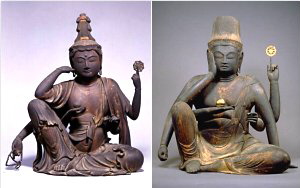
|
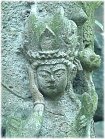 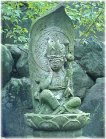
|
|
Nyo-irin Kannon
(L) Kamakura Era, 13th century; (R) Heian, 10th century
Photos Nara National Museum (Japanese language)
|
Nyo-irin Kannon
Stone Statue
Ryutakuji Temple.
Taisho Period.
|
|
|
OUTSIDE RESOURCES ON NYOIRIN KANNON 如意輪観音
- Divine Impersonations: Nyoirin Kannon in Medieval Japan
By Sarah Alizah Fremerman, Ph. D. Thesis (2008), Stanford Univ., Dept. of Religious Studies.
QUOTE: By the late Heian (794-1186) and Kamakura periods, Nyoirin had attained a widespread popularity in Japan that she had likely never enjoyed in China, playing a central role in court rituals; becoming a favorite object of worship for women, associated with fertility, childbirth, and by the Muromachi period (1392-1573) with salvation from the "Blood Pool Hell" (chi no ikejigoku 地の池地獄) and appearing not only in the Shingon pantheon but also in Tendai, Soto Zen, and other sects. She does not appear in medieval tale collections such as the Hokke Genki or Konjaku Monogatari, although she does appear in the 14th-century Shintōshū 神道集, which presents an intriguing topic for future research. To purchase her dissertation, please click here.
- Canonizing Kannon: The Ninth-Century Esoteric Buddhist Altar at Kanshinji Temple
By Cynthea J. Bogel. The Art Bulletin, Vol. 84, No. 1 (March 2002), pp. 30-64.
QUOTE: Annually, on April 17 and 18, devotees flock by the hundreds to Kanshinji Temple, located deep in the mountains south of Osaka, to pray to the temporarily revealed secret image. From a respectful distance they beseech the Nyoirin Kannon for blessings through the power of the "wish-granting gem" held in the innermost right hand of its six arms. Judging by the historical record and applying comparative stylistic analysis, art historians generally date the Nyoirin Kannon statue to about 840. It is thus the earliest surviving Japanese representation of this particular bodhisattva, one of many Esoteric forms of the Kannon (Sanskrit: Avalokitesvara). A temple record dating to 883 shows that the Nyoirin Kannon image was originally but one icon among a group of statues and paintings made for the altar of the monastery's lecture hall.
- JAANUS (Japanese Architecture and Art Net Users System)
aisf.or.jp/~jaanus/deta/n/nyoirinkannon.htm
- Gabi Greve
darumamuseumgallery.blogspot.com/2007/05/nyoirin-kannon.html
haikuandhappiness.blogspot.com/2007/08/hotoke.html

Roku Kannon, Six Kannon 六觀音
Chinese = Liù Guānyīn. Like Japanese groupings of Six Jizō Bosatsu, Kannon is also shown in six basic forms to protect people in each of the six realms of karmic rebirth. Worship of the Six Jizō can be traced back to the 11th century in Japan, but the Jizō grouping has no basis in Mahayana scripture or in the writings of Buddhist clergy. Its origin is probably linked to a similar grouping of Six Kannon that appeared in the early-mid 10th century in Japan’s Tendai 天台 sect, wherein effigies of Six Kannon were used to pray for the welfare of the dead. This grouping of Six Kannon originated much earlier in China, and draws its scriptural basis from the Mohe Zhiguan 摩訶止観 (Jp. = Makashikan), a work written around 594 AD by the noted Chinese Tien-tai master Chih-i 智顗 (538 - 597) that is translated as “Great Concentration and Insight.” By the 11th century, Japan’s Shingon sect also began venerating the Six Kannon. The worship of Six Jizō appeared around the same time. The six emanations of Jizō and Kannon vary among temples and sects. In Japan’s Shingon sect, the Six Kannon also appear frequently in the Rokujikyō Mandara 六字経曼荼羅, which was used in the Rokujikyōhō 六字経法 esoteric rite for childbirth or to ward off illness. <Source: Kashara & McCarthy. A History of Japanese Religion. Kosei, 2001> Learn more about the 6 Realms.
|
Six Manifestations of Kannon
at Daihō-onji Temple 大報恩寺 (Kyoto)
Each associated with one of Six Realms of Reincarnation
- Beings in Hell, Shō Kannon, Holy One, 177.9 cm
- Hungry Ghosts, Senju Kannon, 1000-Armed Kannon, 180.0 cm
- Animals, Batō Kannon, Horse-Headed Kannon, 173.3 cm
- Ashura, Jūichimen Kannon, 11-Headed Kannon, 180.6 cm
- Humans, Juntei Kannon, Pure One, 175.7 cm (See Note 1)
- Deva, Nyoirin Kannon, Jewel & Wheel Kannon, 96.1 cm
NOTE 1: In Tendai texts, Juntei Kannon 准胝 (humans) is sometimes replaced by Fukūkenjaku Kannon.
NOTE 2: Batō Kannon was not part of the original six appearing in the Mohe Zhiguan 摩訶止観 (circa 594 AD); according to the Hishō Mondō 祕鈔問答 by Raiyu 賴瑜 in the 13th century, Batō was inserted into the group by Ningai 仁海 (951-1046), replacing Shishimui Kanzeon 師子無畏觀世音. <Source: DDB, C. Muller>
|
BELOW PHOTOS
Six Kannon 六観音
by Jokei II, Dated +1224
Wood, Treasures of
Daihō-onji Temple 大報
Professor Sherry Fowler
has done extensive research
into the Six Kannon at
Daihō-onji Temple.
SOURCES
Prof. Sherry Fowler, JAANUS,
Kasahara & McCarthy’s A History of Japanese Religion, and the
National Research Institute for
Cultural Properties, Tokyo.
|
|
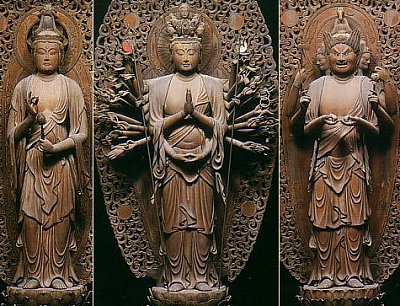
Shō Kannon 聖観音, Senju Kannon 千手観音, Batō Kannon 馬頭観音
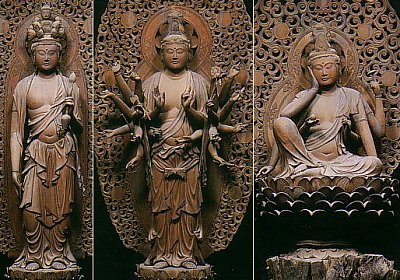
Jūichimen Kannon 十一面観音, Juntei Kannon 准胝観音, Nyoirin Kannon 如意輪観音
Another Varient of the Six Kannon is Shown Below
Source: Soothill's Dictionary of Chinese Buddhist Terms
- 大悲 (Daihi) Most Compassionate (Senju Kannon, 1000-Armed Kannon)
- 大慈 Most merciful (Shō Kannon, Holy Kannon)
- 師子無畏 Of Lion Courage, Fearless (Batō Kannon, Horse-Headed Kannon)
- 大光普照 Of Universal Light, Great Shining Light (Jūichimen Kannon, 11-Headed Kannon)
- 天人丈夫 Leader of Gods & Men, Divine Hero (Juntei Kannon, Pure Kannon)
- 大梵深遠 Great Brahma (Nyoirin Kannon, Jewel & Wheel Kannon)
|
|

Ryūzu Kannon 龍頭観音
 Dragon-Riding Kannon. One of 33 Forms of Kannon in Japan. Says the Flammarion Guide to Buddhism: “Represented as a woman seated on a dragon or on the back of a sea-turtle. In China, this form sometimes holds a child in her arms, and is confused with a giver of children.” <end quote> Dragon-Riding Kannon. One of 33 Forms of Kannon in Japan. Says the Flammarion Guide to Buddhism: “Represented as a woman seated on a dragon or on the back of a sea-turtle. In China, this form sometimes holds a child in her arms, and is confused with a giver of children.” <end quote>
This goddess is often depicted riding a dragon, seated on a dragon, or sometimes standing next to one. Ryūzu Kannon may have originated at Japan’s sacred Mt. Hakusan (which venerates the Shintō Dragon Goddess Shirayamahime 白山比売), but her inclusion in the Chinese Buddhist pantheon suggests otherwise.
The Japanese karate school known as Isshin-Ryū Karate 一心流空手 (“One-Heart Way,” a style of Okinawan karate founded by Tatsuo Shimabuku 島袋龍夫 in the 1950s) adopted Ryūzu Kannon as its patron. To practitioners of Isshin-Ryū Karate, she is known as Isshinryū no Megami 一心流の女神 (“Me” 女 means woman, and “Gami” 神 means deity). This can be translated directly as Goddess of Isshinryū.
Says a practitioner: “The goddess Isshinryū-no-Megami is based on a daydream that Master Tatsuo Shimabuku had in the 1950’s while creating his Isshinryū system. In this dream, Ryuzu Kannon (riding a dragon) came to Shimabuku and told him that he had enough knowledge and experience to create his own style of karate. She told Shimabuku to create an image of her incorporating his vision for the new style.” <Source>
Color Clipart at Right: “The upper body (woman) illustrates that karate can be as gentle or soft as a woman. The lower body (dragon) shows that, if needed, karate can be as fierce or hard as a dragon. The turbulent water symbolizes the possibility of danger, which is always present. The calm face of Goddess Megami helps one remember to remain calm especially in times of crisis.” <Source>
|
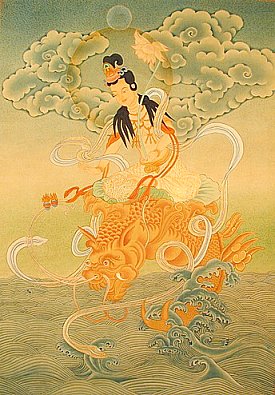
|
Ryūzu Kannon 龍頭観音 (Dragon-Head Kannon)
atop sea monster. Photo from tibetshop.com.
In Japanese paintings, Ryūzu Kannon (one of the 33 traditional forms of Kannon in Japan) is typically shown atop a dragon (a legendary member of the Vedic group of serpentine creatures known in Sanskrit as the Naga). But in this modern Japanese painting, the dragon appears to be a Shachihoko (an imaginary ocean beast with the head of a tiger and the body of a fish). Moreover, the dragon in this painting looks similar to a carp (Jp. = Koi 鯉) transforming into a dragon, a common artistic theme from old China. This theme is based on a Chinese legend (Jp. = Koi-no-Takinobori 鯉の滝登り) wherein carp swim, against all odds, up a waterfall known as the “Dragon Gate” at the headwaters of China’s Yellow River. The gods are very impressed by the feat, and reward the few successful carp by turning them into powerful dragons. The story symbolizes the virtues of courage, effort, and perseverance, which correspond to the nearly impossible struggle of humans to attain Buddhahood. In modern Japan, temples and shrines commonly stock their garden ponds with carp, which grow to enormous sizes in a variety of colors.
|

|
Sanjūsanshin 三十三身 (lit. = 33 Bodies)
Kannon Sanjūsanshin 観音三十三身
33 Forms of Kannon 三十三応現身
Chinese = Guanyin Sānshísānshēn
|
Manifestation Bodies
Keshin 化身 (Chn. = Huàshēn)
Genshin 現身 (Chn. = Xiànshēn)
Ogenshin 応現身, Henge 変化, Hensō 変相
MEANING: Transformation body, avatar, or
manifestations of the Buddha & Bodhisattva.
|
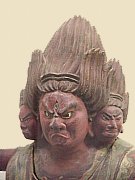 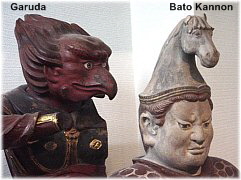 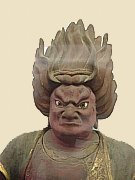
Some of Kannon’s 33 Forms at Hase Dera (Hase Kannon Temple) in Kamakura
Garuda (birdman) & Bato Kannon (Horse Head) are among these deities.
A set of 33 was presented to Hase Dera by Shogun Yoshimasa (1449-1471 AD). More photos below.
|
33 Kannon & the Lotus Sutra
The Lotus Sutra is one of the best known Mahayana scriptures. It’s 25th Chapter is popularly called the Kannon Sutra and often treated as an independent text. The full name of the sutra (25th chapter) is Kanzeon Bosatsu Fumon Bon 觀世音菩薩普門品, wherein are listed Kannon’s 33 basic forms.
Why Number 33 ? The Lotus Sutra mentions 33 forms of Kannon. But it is unclear why the number 33 was used. One theory relates to the Buddhist realm Mt. Shumisen 須弥山 (Skt. = Mt. Sumeru, Mt. Meru) from Hindu mythology. In this heavenly palace of the Buddha and all followers, there are 33 deities who guard and protect the realm. They are commanded by Taishakuten (Skt. = Indra), who governs the other 32 gods who live on the 32 peaks of Sumeru, eight in each of the four directons. Taishakuten’s palace is known as Zenkenjō 善見城 (Palace of Correct Views); also called Kikenjō (Joyful to See), located in the Buddhist heaven called Trayastriṃśas (Skt.) atop Mt. Shumisen. Also, probably related to the 32 realms of Vedic mythology and to the 32 Marks of the Buddha.
|
|
 Kannon can appear in many different forms to save people. The 25th chapter of the Lotus Sutra (Hoke-kyō 法華経) -- a sutra translated into Chinese by Kumārajīva 鳩摩羅什 (350 - 410; Jp. = Kumarajū ) -- is popularly known as the Kannon Sutra (Jp. Kannonkyō 觀音経, Chn. = Guanyin-jing 觀音經). It lists thirty-three forms that Kannon assumes when aiding sentient beings, including that of a monk, nun, official, child, dragon, garuda, general, king, and Buddha. <see below list> Kannon can appear in many different forms to save people. The 25th chapter of the Lotus Sutra (Hoke-kyō 法華経) -- a sutra translated into Chinese by Kumārajīva 鳩摩羅什 (350 - 410; Jp. = Kumarajū ) -- is popularly known as the Kannon Sutra (Jp. Kannonkyō 觀音経, Chn. = Guanyin-jing 觀音經). It lists thirty-three forms that Kannon assumes when aiding sentient beings, including that of a monk, nun, official, child, dragon, garuda, general, king, and Buddha. <see below list>
The Lotus Sutra served as the original scriptural source for the 33 forms of Kannon in Japan, but over the centuries the Japanese portrayed Kannon in various other forms, both in art and in many Kannon miracle stories.
Says Shaku Soen, the mid-20th century abbot of Engakuji Temple in Kamakura: “Kannon will be a philosopher, merchant, man of letters, person of low birth, or anything as required by the occasion, while Kannon’s sole aim is to deliver all beings without exception from ignorance and suffering.” <quoted from Kamakura: Fact and Legend by Iso Mutsu, ISBN: 0804819688 >
|
Sanjūsanzon Kannon 三十三尊觀音 (33 Forms of Kannon)
In Japanese statuary, the 33 forms do not conform to the 33 forms listed in the Lotus Sutra. Instead, they reflect Japan’s own traditions while still remaining faithful to the notion that Kannon appears in many different forms to save people. The names of the 33 in Japan also vary depending on temple or sect. Except for Byakue Kannon, the other 32 forms of Kannon in Japan are not well known. 33 Kannon Pilgrimages. In Japan, there are numerous 33-site pilgrimage circuits sacred to Kannon. Among the best known are the Saigoku Pilgrimage to 33 sites (Kansai area), the Bandō Pilgrimage to 33 sites (Kanto area), and the Chichibu Pilgrimage to 34 sites (Saitama Valley). Together these 100 nationwide sites are extremely sacred to Kannon, and making the circuit to each in proper order is said to save the believer from hell and to open the gates to everlasting life. The 33 forms of Kannon given in the Lotus Sutra (see below chart) are the basis for these pilgrimage circuits. For those who cannot spare the time, miniature circuits (wherein pilgrims can visit 33 images within a single temple compound, like that at Ishiyamadera) are available. In all these pilgrimages, the forms of Kannon don’t match the 33 forms of the Lotus Sutra, but instead feature popular Kannon manifestations such as the 1000-Armed Kannon, the 11-Headed Kannon, the Nyoirin Kannon, and the Shō Kannon.
|
|
33 Forms of Kannon
Listed in the Lotus Sutra
|
33 Forms of Kannon in Japan
Listed in 1690 publication Butsuzō-zu-i 仏像図彙
|
- Buddha 佛 (Jp. = Nyorai)
- Pratyekabuddha 辟支佛 (self-enlightened beings)
- Śrāvaka 聲聞 (Jp. = Arakan)
- Mahābrahman 梵王 (Jp. = Bonten)
- Indra 帝釋 (Jp. = Taishakuten)
- Īśvaradeva 自在天 (Jp. = Jizaiten)
- Maheśvara 大自在天 (Jp. = Daijizaiten)
- Heavenly general 天大將軍
- Vaiśravaṇa 毘沙門天 (Jp. = Bishamonten)
- King 小王
- Rich Man 長者
- Householder 居士
- Prime Minister 宰官
- Brahman 婆羅門
- Bhikṣu 比丘 (a monk; Jp. = biku)
- Bhikṣuṇī 比丘尼 (a nun, Jp. = bikuni)
- Upāsaka 優婆塞 (Buddhist layman, Jp. = ubasoko)
- Upāsikā 優婆夷 (Buddhist laywoman, Jp. = ubai)
- Rich man’s wife or daughter 長者婦女
- Householder’s wife or daughter 居士婦女
- Prime minister’s wife or daughter 宰官婦女
- Brahman’s wife or daughter 婆羅門婦女
- Boy 童男
- Girl 童女
- God (deva) 天 (Jp. = ten)
- Nāga 龍 (dragon)
- Yakṣa 夜叉
- Gandharva 乾闥婆
- Asura 阿修羅
- Garuḍa 迦樓羅
- Kiṃnara 緊那羅
- Mahoraga 摩睺羅迦
- Vajradhara 執金剛
<Adapted from Digital Dictionary of Buddhism
sign in as guest; also see Lotus Sutra, the
摂無礙経 sutra, and SAT Daizōkyō (No. 1912>
|
- Yōryū (Yoryu) 楊柳 (willow Kannon)
- Ryūzu (Ryuzu) 龍頭 (dragon-riding Kannon)
- Jikyō (Jikyo) 持経 (sutra Kannon)
- Enkō (Enko) 円光 (halo Kannon)
- Yūge (Yuge) 遊戯 (playing Kannon)
- Byakue 白衣 (white-robed Kannon)
- Renga 蓮臥 (lotus-resting Kannon)
- Takimi 滝見
- Seyaku 施薬 (medicine-bestowing Kannon)
- Gyoran 魚籃 (fish-basket Kannon)
- Tokuyō (Tokyo) 徳王
- Suigetsu 水月 (water-moon Kannon)
- Ichiyō (Ichiyo) 一葉
- Shōkyō (Shokyo) 青頚
- Itoku 威徳
- Enmei 延命 (life-extending Kannon)
- Shūhō (Shuho) 衆宝
- Iwato 岩戸
- Nōjuo (Nojuo) 能静
- Anoku 阿耨
- Amadai 阿麼提
- Yōe (Yoe) 葉衣
- Ruri 瑠璃
- Tarason 多羅尊
- Hamaguri 蛤蜊
- Rokuji 六時 (six letter; see Rokuji Mandala)
- Fuhi 普悲
- Merōfu (Merofu) 馬郎婦
- Gasshō (Gassho) 合掌 (praying-hands Kannon)
- Ichinyo 一如
- Funi 不二
- Jiren 持蓮 (holding-lotus Kannon)
- Saisui or Shasui 灑水 (water-sprinkling-purifying)
<Sources: Butsuzō-zu-i 仏像図彙
(published in 1783 AD) , JAANUS, and
Ryūkozan Shōbō-in Temple 龍光山正寶院 in Tokyo (Tendai Sect).
|
|

33 Forms of Kannon at Hase Dera in Kamakura
Thirty-three wood-carved figures were presented to Hase Kannon Temple 長谷寺 (Kamakura) by Shogun Yoshimasa (1449-1471 AD). The set originally surrounded the temple’s central image of the 11-Headed Kannon, but they are now housed in the temple’s 2nd-floor treasure house to better preserve them. The 33 forms do not entirely conform to the 33 forms appearing in the Lotus Sutra. They represent the keshin, or incarnations, of the Goddess of Mercy, who, it is said, comes in many forms to save the souls of the suffering. To Tibetans, for example, the Dalai Lama is an incarnation of Kannon. Pictured below are some of the 33 keshin at Hase Dera. Another set of 33 can be found at Ishiyamadera 石山寺 in Shiga prefecture.
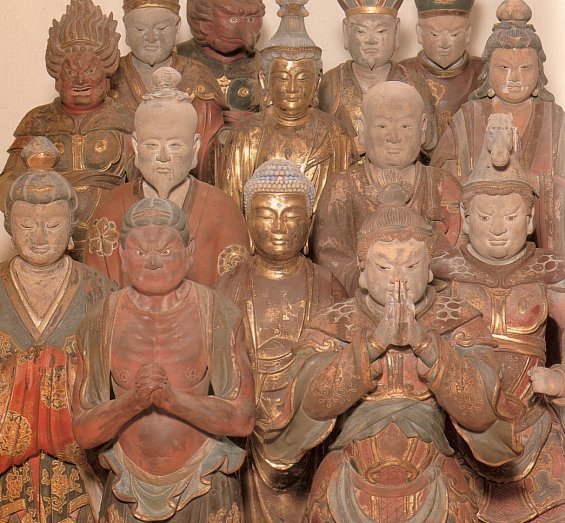
Some of Kannon’s 33 Forms at Hase Dera Temple in Kamakura. Photo scanned from temple brochure.
More Photos of 33 Kannon Statues
kamaishi-daikannon.com/33kannon.html

Senchū Yūgen Kannon 船中湧現観音
 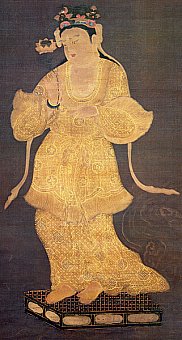  A manifestation of Kannon who calms the raging waters. Says the Flammarion Iconographic Guide: “A particular form of Kannon in Japan, called Senchū Yūgen Kannon 船中湧現観音, appeared to the monk Kūkai on the boat that conveyed him to China in 806. He has the appearance of a Deva, is crowned with flowers, and calms the waves with a gesture of this hand." <end quote, page 169> A manifestation of Kannon who calms the raging waters. Says the Flammarion Iconographic Guide: “A particular form of Kannon in Japan, called Senchū Yūgen Kannon 船中湧現観音, appeared to the monk Kūkai on the boat that conveyed him to China in 806. He has the appearance of a Deva, is crowned with flowers, and calms the waves with a gesture of this hand." <end quote, page 169>
Editor’s note: The term Senchū Yūgen literally means “inspired vision while on a boat.” The deity is also known as Densenchū Yūgen Kannon 伝船中湧現観音.”
Photo at Right
Painting of Senchū Yūgen Kannon 船中湧現観音.
Apparition of Kannon calming the raging waters.
National Treasure of Ryūkō-in Temple (Ryuko-in) 竜光院, Wakayama Prefecture. Dated to the 12th Century. H = 79.4 cm, W = 41.8 cm. Photo from magazine 日本の国宝, #038, Feb. 1997.
 . .
Senju Kannon, 1000-Armed Kannon 千手觀音
 Thousand-Armed Kannon, or Kannon with a Thousand Arms and a Thousand Eyes. One of Japan’s most beloved esoteric forms of Kannon. From the 8th century onward in Japan, Senju Kannon was worshipped independently as a central object of devotion, often prayed to for avoiding illness, eye problems, and blindness. Senju is also one of Six Kannon who protect people in the six realms of karmic rebirth. As one of the six, Senju Kannon watches over the realm of hungry ghosts (gakidō 餓鬼道). Devotion to the Six Kannon appears to date from the early 10th century. Thousand-Armed Kannon, or Kannon with a Thousand Arms and a Thousand Eyes. One of Japan’s most beloved esoteric forms of Kannon. From the 8th century onward in Japan, Senju Kannon was worshipped independently as a central object of devotion, often prayed to for avoiding illness, eye problems, and blindness. Senju is also one of Six Kannon who protect people in the six realms of karmic rebirth. As one of the six, Senju Kannon watches over the realm of hungry ghosts (gakidō 餓鬼道). Devotion to the Six Kannon appears to date from the early 10th century.
ORIGINS. Most scholars believe this esoteric form of Kannon originated in India sometime in the 7th century, and spread thereafter to mainland Asia and lastly to Japan. But artistic representations of this deity (dated to the 7th & 8th centuries) are rare or nonexistent. Extant Chinese representations start around the 10th century. Surprisingly, Japan seems to possess the oldest extant sculptural examples of this deity -- see photo in sidebar (at right) of the 8th century statue at Fujii-dera 葛井寺 in Osaka.
LORE. One oft-told folk story (origin unknown) says that, long ago, Kannon vowed to work unceasingly until all sentient beings could be free of the cycle of suffering (Skt. = samsara). After countless attempts to achieve this, Kannon realizes that countless more people still need saving. This causes such distress that Kannon’s head splits into pieces. Amida Buddha (who Kannon serves) answers by giving Kannon eleven heads to witness the world’s suffering. (Why 11 heads? See 11-Headed Kannon for some plausible explanations.) Kannon is now better able to see and understand the cries of the multitude, but when Kannon reaches out to assist all in need, the deity’s two arms are overwhelmed and split into pieces. Amida Buddha answers again, this time giving Kannon one thousand arms -- each equipped with an eye. The compassionate Kannon has since used 1000 eyes to witness suffering and 1000 hands to relieve it. This story symbolizes Kannon’s ability to embrace and alleviate the suffering of the world. [Source 1 and Source 2]
Editor’s Note: The earliest known reference to this story, in my research, comes from L.A. Waddell, “The Indian Buddhist Cult of Avalokita and His Consort Tara ‘the Savioress,’ Illustrated from the Remains in Magadha,” JRAS (1894), pages 59-60. Yet, this folk story most likely appeared in various forms in past centuries. If any site reader can shed light on this matter, please email me with a certified source. It would be greatly appreciated.
1000 HANDS, 1000 EYES. This deity is said to have one thousand arms, with the palm of each hand containing one eye. This gave rise to the following “longer” versions of the deity’s name:
- Senju Sengen Kannon 千手千眼観音. Literally “Kannon of 1000 Arms & 1000 Eyes.”
- Senju Sengen Kanjizai 千手千眼観自在菩薩. Literally “Kanjizai of 1000 Arms & 1000 Eyes.”
- Sanskrit = Sahasra-bhuja Sahasra-netra Avalokiteśvara (1000 Arms & 1000 Eyes)
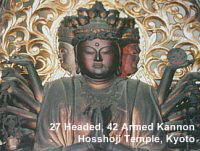 Senju 千手 literally means one thousand arms or one thousand hands. However, since it is extremely hard to carve statues with 1000 arms/hands, most Japanese sculptures of this deity are portrayed with only 42 arms. Ordinarily, two regular arms/hands form the Mudra of Veneration (Jp. = Gasshō-in 合掌印; Skt. = Anjali), while the remaining 40 arms/hands represent the 25 Buddhist worlds. Thus, 40 arms x 25 worlds = 1000. Extant Japanese statuary showing all 1000 arms is rare -- one example is housed at Tōshōdaiji Temple 唐招提寺 in Nara and another at Fujiidera Temple 葛井寺 in Osaka. Eleven heads are typically shown atop the crown of extant Senju statuary (see 11-Headed Kannon), but versions with 27 heads, or just one head with a third eye, also exist. One 27-headed version with 42 arms is housed at Hosshō-ji Temple 法性寺 in Kyoto (see above photo, courtesy this J-site). Senju 千手 literally means one thousand arms or one thousand hands. However, since it is extremely hard to carve statues with 1000 arms/hands, most Japanese sculptures of this deity are portrayed with only 42 arms. Ordinarily, two regular arms/hands form the Mudra of Veneration (Jp. = Gasshō-in 合掌印; Skt. = Anjali), while the remaining 40 arms/hands represent the 25 Buddhist worlds. Thus, 40 arms x 25 worlds = 1000. Extant Japanese statuary showing all 1000 arms is rare -- one example is housed at Tōshōdaiji Temple 唐招提寺 in Nara and another at Fujiidera Temple 葛井寺 in Osaka. Eleven heads are typically shown atop the crown of extant Senju statuary (see 11-Headed Kannon), but versions with 27 heads, or just one head with a third eye, also exist. One 27-headed version with 42 arms is housed at Hosshō-ji Temple 法性寺 in Kyoto (see above photo, courtesy this J-site).
OBJECTS IN HANDS OF SENJU KANNON
Click below chart to visit the Objects Page
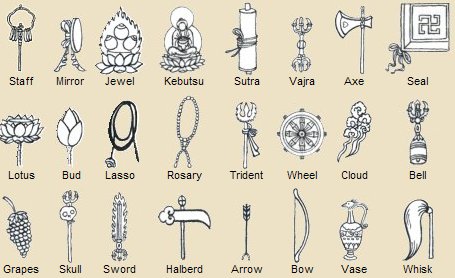
FEATURES OF THE 1000-ARMED KANNON IN JAPAN
- Senju Kannon is lord of the Lotus Court (Renge-in 蓮華印 or Rengebu-in 蓮華部院) of the Taizōkai (Womb World or Matrix Mandala), where Senju is sometimes accompanied by 28 attendants called the Nijūhachi Bushū 二十八部衆 (the 28 Legions), an eclectic group of supernatural creatures and Buddhist deities (adopted from the Hindu pantheon) who assist Senju. This can vary, mind you, for sometimes Senju is only attended by the goddess Kudokuten (aka Kichijōten) and the immortal Basusen. The Renge-in (Lotus Court) is also known as the Kannon-in 観音院. Most esoteric forms of Kannon appear here. In sculpture, extant examples of the Nijūhachi Bushū are rare. Notable examples include Sanjūsangendō 三十三間堂 in Kyoto, Jōroku-ji Temple 丈六寺 in Shiga, and Kōfuku-ji Temple 興福寺 in Nara (only eight of the 28 are extant at Kōfuku-ji). The Oku-no-in of Kiyomizudera in Kyoto houses a hidden image of Senju Kannon crowned with 28 heads, one for each of the 28 protection genii (i.e., Nijūhachi Bushū). They are shown to the faithful only once every 33 years. Their next showing will be in 2010. Says the Flammarion Guide: "In the Garbhadhatu Mandala, these 28 heads are described as representing the 28 constellations. When he presides over the 28 Bushū, he has a third eye." <end Flammarion quote, page 166>
- Senju Kannon also appears in the Kokūzō-in 虚空蔵院 (Court of Kokūzō Bosatsu) of the Taizōkai Mandala with 27 faces and 42 main arms, while innumerable small arms fan out behind. [Source JAANUS]
- Senju Kannon is the patron of people born in the Zodiac Year of the Rat.
- From the 8th century onward in Japan, Senju Kannon was prayed to for curing sickness, relieving eye problems, and avoiding blindness. The famous Chinese monk Ganjin 鑑真 (688-763), the founder and blind preceptor of the Ritsu 律 sect in Japan, was a great devotee of the 1000-Armed Kannon. Ganjin lost his sight during his troubled voyages from China to Japan -- he had been invited to Japan by Emperor Shōmu 聖武 (reigned +724-749) to establish an ordination platform, but suffered five unsuccessful sea voyages to Japan and lost his eye sight in the process. Ganjin enshrined an image of Senju Kannon at his temple, Tōshōdaiji (Toshodaiji) 唐招提寺 in Nara. In the 9th century, the famous court official Sugawara no Michizane 菅原道真 (845-903) “sponsored a ceremonial reading of the Lotus Sutra in memory of his parents, with prayers that Kannon would allow them to be reborn in his Pure Land. Michizane especially venerated Kannon because as a child he had been cured of a serious illness in answer to his parents' prayers to the bodhisattva.” [Source: A History of Japanese Religion, p. 136, Kazuo Kasahara]
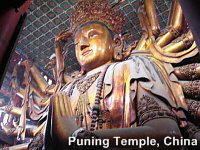  The world's largest statue of the 1000-Armed 1000-Eyed Kannon is reportedly located at Puning Temple in China (Hebei Province). This 18th century wooden sculpture is 23.5 meters in height and weighs about 10 tons. Source: <Source> The world's largest statue of the 1000-Armed 1000-Eyed Kannon is reportedly located at Puning Temple in China (Hebei Province). This 18th century wooden sculpture is 23.5 meters in height and weighs about 10 tons. Source: <Source>
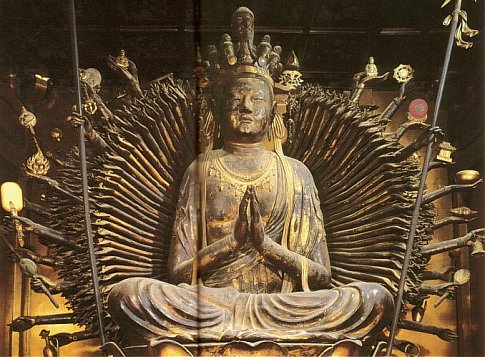
1000 Armed Kannon
Fujii Dera Temple 葛井寺 (Osaka), Dated 752 AD, one of the earliest extant statues of this form of Kannon
Photo scanned from サライ Magazine, 2001.6.7, Vol.13, No.11
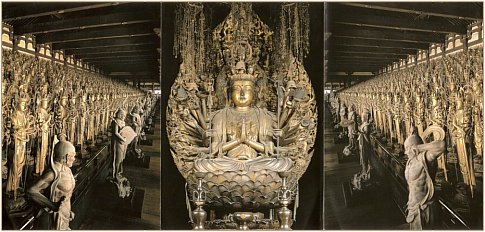
Senju Kannon (Middle Photo)
13th Century, Sanjūsangendō in Kyoto, Carved by Tankei (Unkei’s son)
Photo scanned from temple catalog
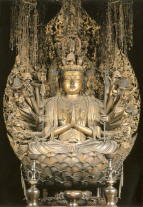 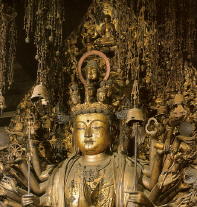 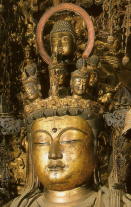
Senju Kannon, 13th Century, Sanjusangendo in Kyoto
Senju Kannon (Closeup), 13th Century. Sanjūsangendō (Kyoto). Photo from temple catalog.
Photo scanned from temple brochure

SHŌ KANNON 聖観音 or 正観音
|

Shō Kannon
Also spelled Sho Kannon, Shou Kannon
Skt. = Āryāvalokiteśvara
Chinese = Shèng Guānyīn
Korean = Seong Gwaneum 성관음

Sanskrit Seed
Pronounced SA サ in Japan
Shingon Mantra (ご真言)
おん あろりきゃ そわか
On Arorikyu Sowaka
|
|
 The Sacred Form of Kannon, the model for other forms of Kannon. Worship of this deity began in India around the 1st or 2nd century AD. Also one of the Six Manifestations of Kannon who protect the six realms of karmic rebirth. In this latter role, Shō Kannon brings salvation to those in the hell realm (in some traditions, Shō Kannon is instead responsible for beings in the realm of hungry ghosts; see Six Kannon). The Sacred Form of Kannon, the model for other forms of Kannon. Worship of this deity began in India around the 1st or 2nd century AD. Also one of the Six Manifestations of Kannon who protect the six realms of karmic rebirth. In this latter role, Shō Kannon brings salvation to those in the hell realm (in some traditions, Shō Kannon is instead responsible for beings in the realm of hungry ghosts; see Six Kannon).
Shō Kannon represents the root form, the unchangeable form, of Kannon -- the pure, noble, sacred, holy form -- while his/her other manifestations are commonly referred to as the 33 Keshin or Henge Kannon. Shō comes from the Sanskrit "Arya," meaning holy. In Japan, another name for Shō-Kannon is Guze Kannon, one referring to the simple (non-esoteric) form of this deity. The earliest extant wooden statue in Japan (first half 7th century AD) is the Guze Kannon housed at Hōryū-ji Temple 法隆寺 in Nara.
In traditional Japanese Buddhist art and sculpture, Shō Kannon commonly holds a lotus bud or water vase (see Objects Page for significance of these important icons), and wears a crown that contains a small image of Amida Buddha (called a kebutsu 化仏). The kebutsu symbolizes Kannon’s role as one of Amida's main attendants.
|

Shō Kannon
Heian Era
Ango-ji Temple
|

Shō Kannon
10th to 11th Century
Tendai-ji Temple (Chuson-ji)
|

Shō Kannon
12th Century
Chuson-ji Temple
|
|

SUIGETSU KANNON 水月観音
|
Suigetsu Kannon 水月観音
Kannon Gazing at Moon in the Water
Chinese = Shuǐyuè Guānyīn
Korean = Suwol Gwaneum 수월관음

Sanskrit Seed
Pronounced SA サ in Japan
Shingon Mantra #1 ご真言
おん はんどましりえい そわか
On Handomashiriei Sowaka

Sanskrit Seed
Pronounced PA パ in Japan
Shingon Mantra #2 ご真言
おん びしゅだ はだま さたば
けいた そわか
On Bishuta Hadama Sataba Keita Sowaka
Photo at Left: Suigetsu Kannon
Tōkeiji Temple 東慶寺 (Kita Kamakura).
Wood, Height 41.7 cm, Kamakura Era
|
|
 Kannon Gazing at the Moon in the Water. One of 33 Forms of Kannon. The imagery is akin to the symbolism of the mirror -- i.e., it represents the emptiness of all phenomena (i.e., life is illusion), for the mirror does not represent reality -- it merely provides a reflection of reality. Thus, the mirror is a metaphor for the unenlightened mind deluded by mere appearances. Also see the famous Buddhist parable from China known in Japan as Enkō Sokugetsu 猿猴捉月. Translated as "Catching the Moon’s Reflection," it tells a similar story of the unenlightened mind deluded by appearance, one evoking the emptiness of the moon’s reflection in water. Kannon Gazing at the Moon in the Water. One of 33 Forms of Kannon. The imagery is akin to the symbolism of the mirror -- i.e., it represents the emptiness of all phenomena (i.e., life is illusion), for the mirror does not represent reality -- it merely provides a reflection of reality. Thus, the mirror is a metaphor for the unenlightened mind deluded by mere appearances. Also see the famous Buddhist parable from China known in Japan as Enkō Sokugetsu 猿猴捉月. Translated as "Catching the Moon’s Reflection," it tells a similar story of the unenlightened mind deluded by appearance, one evoking the emptiness of the moon’s reflection in water.
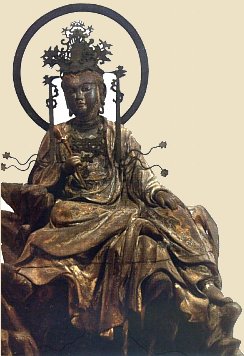
Suigetsu Kannon Reproduction
http://www3.ocn.ne.jp/~k.hosoda/649-A_bessonnzakki.htm

Tara (Tarani) Bosatsu 多羅菩薩
|
Tara Bosatsu 多羅菩薩
Also called Tarani Bosatsu
Skt. = Tārā Bodhisattva
Chinese = Duōluó Púsà
Korean = Dara Bosal 다라보살
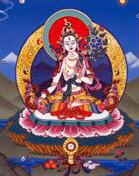
Tibetan Image from Web
|
|
 Kannon's female manifestation. Also known as Tarani Bodhisattva. Goddess. One of 33 Forms of Kannon. Not until the 4th century AD does the feminine principle gain acceptance in Mahayana traditions in mainland Asia. Around the 6th century, the goddess Tara appears as Kannon’s Śakti, the “female personification” or “female energy” of the male Kannon. Tara is sometimes depicted as Kannon’s wife; not widely known in Japan or China. In China, said to have sprung from the eye of Guanyin (Kannon). Kannon's female manifestation. Also known as Tarani Bodhisattva. Goddess. One of 33 Forms of Kannon. Not until the 4th century AD does the feminine principle gain acceptance in Mahayana traditions in mainland Asia. Around the 6th century, the goddess Tara appears as Kannon’s Śakti, the “female personification” or “female energy” of the male Kannon. Tara is sometimes depicted as Kannon’s wife; not widely known in Japan or China. In China, said to have sprung from the eye of Guanyin (Kannon).
In the 7th century, the Chinese pilgrim Xuanzang claimed to have seen many statues of this deity in northern India. However, the deity was not accepted by followers of the Theravada, and her images are found rarely in Sri Lanka or in Southeast Asia (except in Java, where a temple was dedicated to her in 779).
Many legends have sprung up around this goddess. According to one, she was born in a beam of blue light emanating from one of the eyes of Avalokitesvara (i.e., Kannon). In Tibet, around the 7th century, came the idea that virtuous and pious woman were incarnations of Tara. Two of the wives of King Srong-btsan Sgam-po of Tibet -- the Chinese woman Wencheng and the daughter of Nepal’s Amsuvarman -- are considered to be manifestations of Tara. To differentiate between the two wives, the Tibetans created two distinctive Taras, white for the Chinese, with a full-blown lotus as her emblem, and green for the Nepalese, whose emblem is the blue (half-open) lotus. Each was supposedly born from an eye of Avalokitesvara (open and half-closed). Hence they came to be considered as symbols of the day (full-blown lotus, eye open) and the night (half-open lotus, eye half-closed). In China, this goddess is not well known or represented. In Japan, she was given the rank of Bodhisattva, where her manifestation combines both colors, but she is found only rarely in Japan, and usually only on mandalas or on temple banners. She holds a pomegranate (symbol of prosperity) and a lotus, and is normally depicted in pale green color (in Japan, the word for blue can also be used for the color green)
Says JAANUS: “A female form of Kannon who appears as the ’mother’ of the Kannon section (Kannon-in 観音院 or Renge-in 蓮華院) of the Taizoukai Mandara 胎蔵界曼荼羅. It is recorded that Xuanzhuang (Jp: Genjou 玄奘, d. 664) saw the image Tara Bosatsu in India, and several texts devoted solely to her were translated from the end of Tang and during the Song Dynasties (10th to 13th centuries). She is mentioned in the FUKUUKENJAKU SHINPEN SHINGONGYOU 不空羂索神変真言経. She appeared in art in India as an attendant of Kannon in the Gupta period (6-7c); was shown commonly as a single deity in sculpture of the Pala period (9-12c); is shown in relief sculptures in Java in the 8-9c; was and is, in Tibet, a female alternate of Kannon; and appeared in her Indian/Tibetan form in paintings at Dunhuang (Jp: Tonkou 敦煌). However, she appears not to have had an independent cult in Japan, since there are no independent images. In the Taizoukai Mandara she holds a lotus and is clothed from her neck to her ankles in robes that reveal nothing of her physique. An alteration from her Indian representation may have occurred in China.” <end JAANUS quote>

War Dead Kannon
Dozens of Dai-Kannon 大観音 (Big Kannon).statues have been erected in recent times (post WWII onward). Many were built to pray for world peace and for the repose of the war dead and the victims of the atomic bombings. Some examples are presented below.
|
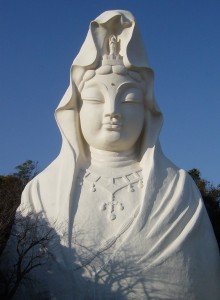
|
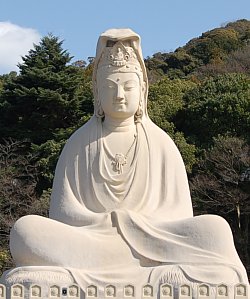
|
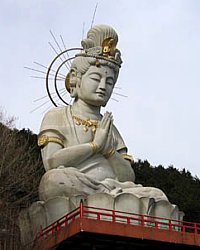
|
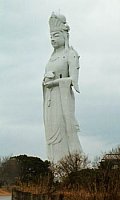
|
|
White-Robed Kannon or
Byakue Kannon 白衣観音
WHERE: Ofuna, Kanagawa
HEIGHT: 29.39 meters
Work on this statue began in 1934, but the outbreak of the second world war halted construction, which began again after the war, and was completed in 1961. The complex here contains stones from ground zero at Hiroshima and Nagasaki, as this temple commemorates the souls of those who died in the atomic bomb attacks, and prays for permanent world peace. The temple holds a festival each September.
|
Ryōzen Kannon 霊山観音
WHERE: Kyoto, Japan.
HEIGHT: 24 meters
An effigy of the White Robed Kannon. Made with 500 tons of concrete with steel-rod frames, this statue was unveiled in 1955 to commemorate the soldiers who died in WWar II and to pray for a peaceful Japan. The memorial’s own brochure is entitled “A Tribute to The Unknown Soldier, World War II.” Made by famous Showa-era sculptor Yamazaki Chōun 山崎朝雲 (1867 - 1954). Ryōzen 霊山 (or 靈山) is the Japanese term for Vulture Peak (aka Eagle Mountain), a mountain in India frequented by the Historical Buddha and a place where he delivered several sermons.
|
Usami Kannon 宇佐美観音
WHERE: Ito City, Shizuoka
HEIGHT: 50 meters.
This statue of the Kannon was constructed in 1982 to pray for global peace. Located in Shizuoka Prefecture, Ito City, in the tiny town of Usami. The Kannon sits on a hill above the town. Reportedly the largest sitting statue of Kannon in Japan. The temple grounds hold a broad array of statues, including those from Tibet and Nepal, numerous mandala, and statues of the Seven Lucky Gods. Some web sites claim it is an effigy of Jibo Kannon 慈母 (Loving Mother Kannon), but I have yet to confirm this.
|
Tokyo Bay Kannon
東京湾観音
WHERE: Futtsu City, Chiba
HEIGHT: 56 meters
Constructed in 1961, this standing statue of Kannon, was erected in memory of the war dead. Financed by a private donor. Visitors can climb up 314 steps inside the statue. Inside the statue's crown is a power system for lighting 10,000 candles (for the Festival of Ten Thousand Lights, held during the August Obon season).
|
|
Kannon Memorials on Behalf of the War Dead
Writes scholar Mark R. Mullins in The Many Forms and Functions of Kannon in Japanese Religion and Culture: “Numerous religious institutions and municipalities have built memorials and regularly conduct rituals on behalf of the war dead. In most cases, Kannon has been selected to serve as the central figure to care for the spirits of the dead and to comfort the spirits of those left in the land of the living. Several examples are worth noting here.
- Koa Kannon in Atami. The Koa Kannon was initially established because of the strong desire of Iwane Matsui, a general in the Japanese army, to memorialize and comfort those who died in the war with China (1937), including both Chinese and Japanese soldiers who lost their lives in the conflict. The Kannon image was established for this purpose in 1940. At the end of World War II, Matsui stood trial and was convicted as a Class-A war criminal and was executed on December 23, 1948. In 1960 the remains of Matsui and six other executed Class-A war criminals were enshrined in the precincts. In addition, there are memorials for 1,619 individuals convicted as Class-B and Class-C war criminals. There is also a memorial to Radhabinod Pal, who served as a judge and representative of India during the Tokyo War Crimes Trials.
- Tokko Heiwa Kannon-sama. Setagaya Kannon Temple. Dedicated to the memory and care of the Tokkotai -- almost five thousand kamikaze pilots -- who died on behalf of the nation. Shō Kannon is the principle image (honzon) enshrined here.
- Kamikaze Peace Kannon Shrine. In the town of Chiran in Kagoshima Prefecture, in honor of the some one thousand kamikaze pilots who flew out from the Chiran bases (as well as other bases) in the last days
- Peace Parks and Memorials. Giant Kannon statues have been erected in numerous locations in Japan, including Ofuna, Nagasaki, Hiroshima, and Okinawa. A Kannon statue was placed at the Hiroshima Memorial Mound, which contains the ashes of the unidentified victims of the atomic bomb. Another was placed in the Hall of Mourning, which was built in the Nagasaki Peace Park in 1995. They are especially dedicated to the unknown dead, whose "untimely" or "bad" death resulted from the atomic bombs.” <end abridged quotes from Mark R. Mullins>

|
Chinese Beauty Who
Embodies Feminine Ideal
of Tang-Era China (618-907)
Yōkihi 楊貴妃
Also spelled Yokihi or Youkihi
Chinese = Yangguifei
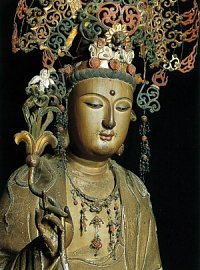
Yōkihi Kannon 楊貴妃観音
Sennyūji Temple 泉涌寺/ 泉湧寺 (Kyoto)
13th Century, Wood. Made in prayer for
Yangguifei's happiness in the next life.
One early example of representations
including religious images that were
created out of her legend. Photo this J-site.
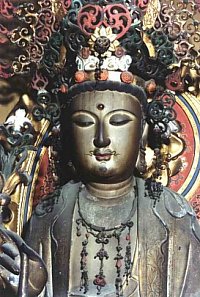
Yōkihi Kannon 楊貴妃観音
Same statue as prior photo. Photo this J-site.
|
|
 Yōkihi Kannon 楊貴妃観音 Yōkihi Kannon 楊貴妃観音
Yōkihi is the Japanese reading for Yangguifei (719-756 AD), a famous Chinese beauty and the concubine of China’s Emperor Xuanzong 玄宗 (Jp. = Gensō 玄宗; 685-762). Her depictions in Chinese and Japanese art epitomize the feminine ideal of Tang-era China.
Says JAANUS: The wife of Emperor Xuanzong's son, Yangguifei caught the eye of the aged-emperor, over sixty at the time, and became his consuming passion. As his favorite she used the emperor's affection to secure high positions for her family, and so aroused much resentment. During the 755 rebellion led by An Lushan 安禄山 (Jp: An Rokusan, ?-757), the emperor and Yangguifei fled the capital for Sichuan 四川 with loyal troops. When the entourage reached the village of Mawei 馬嵬, the soldiers demanded the execution of Yangguifei, the perceived cause of the social unrest. Heartbroken but powerless, the emperor permitted Yangguifei to be killed. After suppressing the rebellion and returning to the capital, the emperor was haunted by the desire to see Yangguifei again. He summoned a Taoist wiseman to search for her spirit. The sorcerer eventually found her living on Penglaishan (Jp: Houraisan 蓬莱山), the Isle of the Immortals, and he returned with some mementoes and a message for the emperor. This tragic story is told in the famous narrative ode "The Song of Everlasting Sorrow" (Ch: Changhenge, Jp: Chougonka 長恨歌) by the Tang poet Bai Letian 白楽天 (Jp: Haku Rakuten, 772-846). The poem became popular in Japan, especially at the Heian court, where its influence extended to GENJI MONOGATARI 源氏物語 (The Tale of Genji ; early 11c). In Japanese eyes, Yangguifei is an enormously sympathetic character. Her story was eventually adapted into the Nou 能 play YOUKIHI by Konparu Zenchiku 金春禅竹 (1405-1468) and retold in popular songs of the Edo period. The earliest Japanese painted depictions of Yangguifei are in illustrations of "The Song of Everlasting Sorrow.” In the 16-17c, interest in the ode had developed into a broader taste for screen paintings of imaginary Tang court scenes, featuring beautiful Chinese women. Chief among these paintings are scenes of "elegant battles" (fuuryuujin 風流人), showing two teams of courtiers, led by Xuanzong and Yangguifei, holding flowers as if spears. Yangguifei has long been associated with erotic themes, evident in Edo period painting subjects such as "Youkihi mounting a horse" and "Gensou teaching Youkihi to play the flute" found in paintings by Gen Ki 源き (1747-97) and Iwasa Matabee 岩佐又兵衛 (1578-1650, MOA), as well as in many ukiyo-e 浮世絵.” <end JAANUS quote>
Why the mustache? Since this statue of Yōkihi Kannon at Sennyūji Temple (Kyoto) is said to embody the feminine ideal, people are often confused by the mustache on her face. Cate Kodo Juno, an ordained Buddhist priest of Japan's Shingon sect, asked the monk of Sennyūji Temple about this iconography. She was told "It is not actually a mustache. It is a vapor emanating from her mouth that indicates the sacred nature of her speech. This is one of the characteristics of a Bodhisattva." <2009, Cate Kodo Juno> This charming explanation is perhaps adequate for worshippers and art lovers, but it is not supported by Buddhist scriptures. The orthodox view is that all Buddha and Bodhisattva are male, and that females cannot achieve these states unless they are first reborn into manhood. That view was much weakened by the widespread popularity of the Lotus Sutra during Japan's Heian era (794-1185 AD), a scripture in which an eight-year old girl achieves enlightenment. Nonetheless, there are many statues in Japan with feminine features that sport mustaches. The addition of the mustache was apparently "intentional" and meant to emphasize the absence of sexual identity. Thus, softness of demeanor and facial features (indicating femininity) were combined with facial hair (indicating masculinity), thereby transcending worldly notions of male and female forms. Incidentally, Cate Kodo Juno is a fervent Kannon devotee. Her website, SacredJapan.com, reviews all 33 temples along the Saigoku Sanjūsan Kannon Reishō (a popular pilgrimage circuit devoted to Kannon).

|
Willow Kannon
Yōryū Kannon 楊柳観音
Chn = Yángliǔ Guānyīn
Krn = Yangnyu Gwaneum 양류관음

Sanskrit Seed
Pronounced SA サ in Japan
Shingon Mantra ご真言
おん ばさらたらままや べいさぐる
あらじゃや そわか
On Basarataramamaya Beisaguru
Arajyaya Sowaka
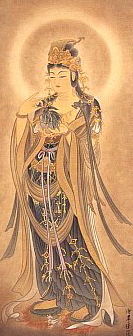
Modern Painting of Willow Kannon
Photo courtesy this J-store.
|
|
 Yōryū Kannon 楊柳観音 Yōryū Kannon 楊柳観音
Lit. = Willow Kannon. Also known as Yakuō Kannon 薬王観音 (Medicine King). One of 33 Forms of Kannon, shown holding a willow branch, which is said to ward off and cure illness. In January each year, Rengeō-in Temple 蓮華王院 (Hall of the Lotus King) in Kyoto holds the Rite of the Willow (Yanagi no Okajidaihōyō 楊枝のお加持大法要), which originated in the Heian period, in which worshippers are touched on the head with a sacred willow branch to cure and prevent headaches, and to pray for another year of good health. Says the Flammarion Guide: “The leaves and bark of the weeping willow contain salicylic acid which cures many ailments and calms fever, medicinal properties which have been known in Asia from antiquity and which are now used in the manufacture of aspirin." (p. 157).
Says the Digital Dictionary of Buddhism: “Thus called because the deity is as flexible to the will of all beings as willow branches to the wind.”
Says JAANUS: The Shō Kannon Kyō 請觀音經, a scriptural source for the Six Kannon, mentions the offering of a willow twig and pure water to Kannon. Since the Tang dynasty, it has been believed that disasters could be warded off by making such an offering . The willow twig, in fact, has appeared in various forms, for example, in one of the hands of the Thousand Armed Kannon. A document from the period of retired Emperor Shirakawa 白河 (1053-1129) states that an image of Byakue Kannon (White-Robed Kannon) enshrined at the Shingon-in 真言院 of the Imperial Palace was holding a willow branch. Nyoirin Kannon (Bodhisattva of the Jewel and the Wheel) may likewise be depicted as holding a vase with a willow twig. A more commonly identifiable Yōryū Kannon may be shown as wearing flowing robes and sitting on a rock in the ocean. A boy in a boat may also be shown near him, an image found in the Kegonkyō 華厳経 (Flower Garland Sutra; Skt. = Avatamsaka Sutra) where youth Zenzai Dōji 善財童子 visits Kannon in a boat during his quest for wisdom. <end JAANUS quote>

 Yume Chigai Kannon 夢違観音 Yume Chigai Kannon 夢違観音
Lit. = Dream-Changing Kannon.
Also read Yume Tagae Kannon.
This statue reportedly changes bad dreams into good dreams.
One of four Kannon statues designated as national treasures at
Hōryū-ji Temple 法隆寺 in Nara.
PHOTO:
Yume Chigai Kannon
8th Century, Hōryū-ji Temple 法隆寺 in Nara

Yumedono Kannon 夢殿観音
A famous statue that was hidden for centuries inside the Yumedono Hall 夢殿 (Dream Hall) at Hōryū-ji Temple 法隆寺 in Nara. The statue was reportedly made in the image of Prince Shōtoku Taishi (the first great patron of Buddhism in Japan) and was wrapped in some 500 yards of white cloth when it was first unveiled in 1884. The statue is commonly known as the Guze Kannon (see Guze entry for details).

RITE OF REPENTANCE
SHUNI-E CEREMONY FOR KANNON
Special Kannon Ritual at Tōdaiji (Todaiji) Temple in Nara
Below Text Courtesy of Temple’s English Brochure
<Source: Todaji Temple English Brochure> The Shuni-e Ceremony is best known by the name of Omizutori. Begun in 752 AD by Jitchuu, the chief disciple of Rōben who founded Tōdaiji Temple, the ceremony is formally a rite of repentance to the Eleven-Headed Kannon in which penitence for one’s misdeeds is sought in front of an image of the 11-Headed Kannon (Jp. = Senju Kannon). Due to the Three Poisons -- covetousness, anger, and ignorance that are the true nature of humans -- we commit myriad offenses which accumulate as contaminants of the spirit; as a result we become unable to see the truth and we also become ill. Through the ceremony, one can repent one’s misdeeds and attain a pure mind and body, do away with the misfortune and woes that are the retribution for one’s evil deeds, and obtain well-being. However, although the Shuni-e is a rite of repentance, it is important to remember that when it was begun it was a ritual performed on behalf of the state. Natural disasters, epidemics, and rebellions were all seen as “illnesses” of the state and the ritual was performed in order to cure such illnesses, to gain a fruitful harvest of the Five Crops, and to achieve peace under heaven -- in other words, to guarantee the welfare of the people.
When the rite of repentance is for the state or all its people, a special group of performers and a ceremony of a suitable scale become necessary. Thus, rites of repentance as services to be held by a large number of monks were devised and the Shuni-e Ceremony took form as on such ritual. The monks who participate in it are called the RENGYOUSHUU. Presently their number is eleven, among whom various responsibilities are divided. The four senior positions include the WAJOU, who administers the Buddhist precepts to the entire group; the DAIDOUSHI, who chants the prayers and the essence of various texts and who functions as the leader of the whole ceremony; the SHUSHI, who determines the sacred boundaries of the ritual space and who intones the daranis (secret incantations) while forming mudras (symbolic hand gestures); and the DOUTSUKASA, who ensures that the ceremony proceeds properly and is in charge of miscellaneous affairs surrounding the Shuni-e Ceremony. The remaining seven participants are known as the HIRASHUU. In addition, there are a number of people who assist the RENGYOUSHUU, so in all almost 30 individuals are directly involved with this ceremony.
The RENGYOUSHUU repent misdeeds on behalf of all people and seek their welfare by praying to Kannon. Since they function in many ways as intermediaries between Kannon and ordinary people, they must possess a considerable amount of religious insight.
The ceremony begins with a preparatory period held at the Kaidan-in between the 20th and the 28th of February, known as the BEKKA. During this time the RENGYOUSHUU cut themselves off from their usual lives and gradually purify their minds and bodies. In addition they prepare the paper for paper garments, known as KAMIKO, worn only during the Shuni-e Ceremony and they make artificial camellias used to ornament the altar of the Nigatsu-dou and practice SHOUMYOU, the chanting of Buddhist sutras.
On the afternoon of February 28th when the BEKKA ends, the RENGYOUSHUU move to the Shelter of Reclusion located below the Nigatsu-dou, where they reside for the duration of the ceremony. Late that evening the main ceremony begins. Lasting two weeks it is divided into the Former Seven Days and the Latter Seven Days. In turn, each day of the ceremony is divided into six periods: noon watch, sunset watch, first evening watch, mid-evening watch, latter evening watch, and dawn watch, which are known as the Observances of the Six Hours (Rokuji no Gyoubou). Because the sutras chanted at each time vary according to their length and speed, throughout the day the SHOUMYOU is exceedingly varied. In many ways, this recitation should be seen as a type of Buddhist music.
During the first evening watch, the Register of the Names of the Kami (JINMYOU-CHOU) is presented and read, a practice of great antiquity. When Monk Jitchuu first held the Observances of the Six Hours, at the presentation and recitation of the names of the Kami (Shinto divinities), he summoned the myriad Shinto deities throughout the land and they rushed to the Nigatsu-dou to pray for the success of the ceremony and to provide it with protection. But the god O-Nyuu Myoujin of Wakasa was late because he had been fishing. It is said that when he finally did arrive just as the observance was ending, he was so moved that he promised that he would provide lustral water to apologize for his tardiness. Thereupon, two comorants, one white and one black, shattered a great boulder and water gushed out of the ground. From that time onward, sacred water has flowed plentifully from the spring. After midnight on the 12th day of the ceremony, this sacred water is drawn and offered to Kannon, and it is from this practice that the name OMIZUTORI, literally “the drawing of water,” is derived.
Other parts of the ceremony include the HASHIRI, when the RENGYOUSHUU tuck up their robes and running, circumambulate the inner sanctum; the fire ritual known as the DATTAN, in which a great pine torch is swung about in the inner sanctum; and the presentation and recitation of the Register of the Names of the Dead, including that of the legendary Lady in Blue who is said to have appeared during the ceremony in the Kamakura Period inquiring as to why her name was not included in the list. It has been thus performed from that time onward. <end quote from Todaiji Temple, Nara>

LEARN MORE
Online Store
  Hand-carved statues of Kannon are available for online purchase at our sister site, Buddhist-Artwork.com. Our store sells quality hand-carved wooden Buddha statues and Bodhisattva statues, especially those carved for the Japanese market. It is aimed at art lovers, Buddhist practitioners, and laity alike. Just like this site (OnmarkProductions.com), it is not associated with any educational institution, private corporation, governmental agency, or religious group. Hand-carved statues of Kannon are available for online purchase at our sister site, Buddhist-Artwork.com. Our store sells quality hand-carved wooden Buddha statues and Bodhisattva statues, especially those carved for the Japanese market. It is aimed at art lovers, Buddhist practitioners, and laity alike. Just like this site (OnmarkProductions.com), it is not associated with any educational institution, private corporation, governmental agency, or religious group.
Resources
- JAANUS. Japanese Architecture and Art Net Users System. Outside link. No longer online. A wonderful online dictionary that included many details on Kannon Bodhisattva in Japanese art. Also included separate entries on many Kannon manifestations in Japan.
- See Bibliography for our complete list of resources on Japanese Buddhism, or visit any site page and scroll to the bottom for detailed resources on that specific deity or topic.
- A Dictionary of Chinese Buddhist Terms. With Sanskrit & English Equivalents. Plus Sanskrit-Pali Index. By William Edward Soothill & Lewis Hodous. Hardcover, 530 pages. Published by Munshirm Manoharlal. Reprinted March 31, 2005. ISBN 8121511453.
- Butsuzō-zu-i 仏像図彙, the “Collected Illustrations of Buddhist Images.” Published in 1690 (Genroku 元禄 3). One of Japan’s first major studies of Buddhist iconography. Hundreds of pages and drawings, with deities classified into approximately 80 (eighty) categories. Modern-day reprints are available at this online store (J-site).
- Mandara Zuten 曼荼羅図典 (Japanese Edition). The Mandala Dictionary. 422 pages. First published in 1993. Publisher Daihorinkaku 大法輪閣. Language Japanese. ISBN-10: 480461102-9. Available at Amazon.
- Kokugakuin University Shinto Online Dictionary
- Digital Dictionary of Chinese Buddhism (C. Muller; login "guest")
- Nanzan Institute for Religion and Culture. Numerous online scholarly papers and its semi-annual Japanese Journal of Religious Studies.
- Mark R. Mullins, The Many Forms and Functions of Kannon in Japanese Religion and Culture. Published in the April-June 2008 issue of Dharma World. Mullins is a member of the Faculty of Liberal Arts and Graduate School of Global Studies at Sophia University, Tokyo, where his teaching and research focuses on religion in modern society.
- John Nelson, "From Battlefield to Atomic Bomb to the Pure Land of Paradise: Employing the Bodhisattva of Compassion to Calm Japan's Spirits of the Dead," Journal of Contemporary Religion 1, no. 2 (2002): 160-61. Nelson is associate professor at the Department of Theology and Religious Studies, University of San Francisco.
- Buddhism: Flammarion Iconographic Guides, by Louis Frederic, Printed in France, ISBN 2-08013-558-9, First published 1995. A highly illustrated volume, with special significance to those studying Japanese Buddhist iconography. Includes many of the myths and legends of mainland Asia as well, but its special strength is in its coverage of the Japanese tradition. Hundreds of accompanying images/photos, both B&W and color. A useful addition to your research bookshelf.
- A History of Japanese Religion. Edited by Kazuo Kasahara. Kosei Publishing Company, 2001. Translated by Paul McCarthy and Gaynor Sekimori. 648 pages. Sixteen distinguished experts on Japanese religion approach the topic from modern perspectives. Topics range from prehistoric times up until the early postwar years. Click here to read review of book by scholar Paul L. Swanson.
- Canonizing Kannon: The Ninth-Century Esoteric Buddhist Altar at Kanshinji Temple, by Cynthea J. Bogel. The Art Bulletin, Vol. 84, No. 1 (Mar., 2002), pp. 30-64.
- Kannon – Divine Compassion: Early Buddhist Art from Japan. Edited by Katharina Epprecht. 196 pages, Hardback, 85 illustrations, ISBN: 978 3 907077 30 6.
- Divine Impersonations: Nyoirin Kannon in Medieval Japan, by Sarah Alizah Fremerman, Ph. D. Thesis (2008), Stanford Univ., Department of Religious Studies.
- Manjushri.com - Avalokitesvara Page. Research on Kannon from Manjushri.com.
- O-Shichi Kannon. Relatively modern Kannon form in memory of Yaoya O-Shichi and the great fire in Edo in 1682. Also see list of Okayama Prefecture 33 Kannon Pilgrimage.
- Temple of the Lotus (J-site with numerous old drawings of the 33 Kannon forms)
Sanskrit Images & Mantras
Museums & Photo Resources

Last Update May 12, 2012 = Updated Fudarakusen section
Last Update April 9, 2011 = Added Fure-ai Kannon (“Touch Me” Kannon)
Last Update July 5, 2011 = Bishamonten as a manifestation of Kannon
|
|